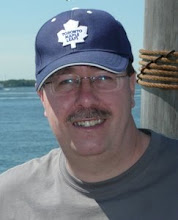Flying
Ottawa Checkride: 0.5 Hrs logged 20l fuel
Ottawa to Massena: 0.8 Hrs logged 33l fuel
Massena to Westchester: 2.7 Hrs logged 94l fuel
New York low level route: 1.1 Hrs logged 41l fuel
Westchester to Niagara: 2.8 Hrs logged 91l fuel
Niagara to Toronto City: 1.2 Hrs logged 41l fuel
Toronto City to Ottawa: 2.4 Hrs logged 82l fuel
Total: 11.5 Hrs logged 402l fuel
Costs
Total cost from Ottawa Flying Club (wet rate): $CAN1770.00
Extra fuel costs (over and above OFC): $CAN 120.00
Handling charges: $CAN 60.00
Total cost of flying: $CAN1950.00
Highlights
Minor scud running the last 30 miles into Westchester for New York
New York low level flight around Manhattan etc.
Niagara Falls
Coming into and flying out of Toronto City airport – very scenic
Flight over Kingston on a glorious day
Serious sideslipping into Ottawa having been left very high and short by traffic and ATC
Getting US ATC units to understand my callsign (they are used to the American format of numbers and letters), the Canadian ‘UK style all-letter’ format seemed to defeat many of them!
1-800-WX BRIEF – flight planning made a pleasure US style
Having a serious discussion with Canadian customs about forgetting to declare the purchase of three New York branded baseball hats for a total of $US12.00
Mistakes and irritations
US Homeland Security – the all important ‘appearance of doing something’
Not adjusting the radio / intercom leaving the radio too loud and the intercom too quiet.
Lining up on the wrong runway to land at Westchester, spotted it myself in enough time though
Accidentally knocking off the intercom and thinking it was my headset leading to one hour of silence and miming
Forgetting to close my flight plans – twice!
Taxiing past the hold at Westchester without clearance
Personal Firsts
Flying P1 in Canada
Flying P1 in the USA
Crossing the Canada / US border
Using the US flight following
Touring in a Cessna 172
Summary
All in all a great trip and one where all the prior planning and preparation paid off and made it so much easier and less stressful than it could have been. I was delighted with the relative freedom and relaxed attitude to flying that exists in Canada and the US. Great countries to tour with huge airports and modest if any landing fees. The highlights had to be the New York low level route and coming in to Toronto City – both highly recommended.
Next Year
I hope to visit a relation in Texas, join up with my buddy who will travel down and do a few days flying touring around Texas, New Mexico and Utah – yeehaa!
Friday, August 29, 2008
CAN/USA: Toronto City to Ottawa
Route: CYTZ (Toronto City) DCT Oshawa DCT Trenton DCT Kingston DCT Brockville DCT CYOW (Ottawa International)
Logged: 2.4 Hours
Fuel: 80 litres approx
We had an evening and a short morning in Toronto. In the evening we treated ourselves to a superb meal and fine wine at ‘The Keg’ (upmarket restaurant chain) in downtown Toronto. The next morning on checking the weather channel, it was calling for cloudy in the morning and rain in the afternoon. Rather than risk getting ‘stuck’ into Toronto by sticking with the original schedule, we decided to have a quick whip around the ‘Hockey Hall of Fame’ as early as we could then hot foot it over to the City Airport and make it out before midday.
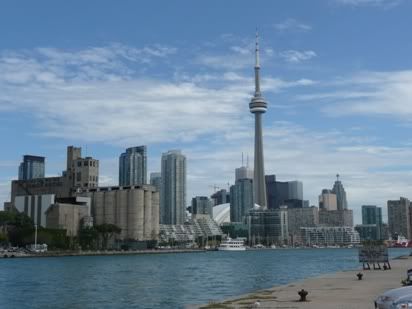
This is how it turned out. I was a bit miffed that the Hockey Hall of Fame didn’t open until 0930, but there it is, we managed to have a look and buy a few souvenirs. We got the free ferry to the island and wandered around to the handling office. I did the flight planning with the equally wonderful Canadian equivalent of WX BRIEF, in this case 1-866-WX BRIEF. Got the weather, NOTAM’s and lodged a flight plan.
Dan headed out to the plane to untie it, pack it and do the A-check, while I settled up at the desk. Well, this was by far the most expensive of the whole trip, with handling and landing fees coming out at $CAN35 - about £18 - what I would pay for a single landing at Gloucester.
They were very helpful on reception and a talkative mechanic wandered by and told me that because of the airshow due that weekend (Canadian and USA Labor Day), there was a Spitfire in the hangar. Of course I just had to have a look on the way out.
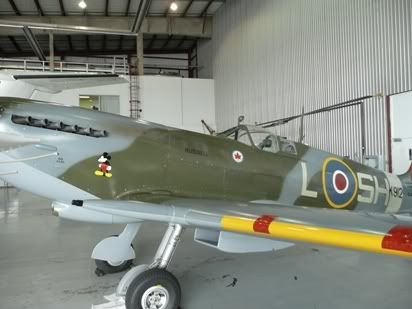
There was also a nice line-up of yellow Harvard trainers on the pan.
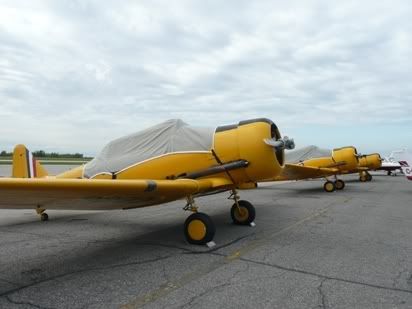
Dan had done a good job and I just checked the oil and fuel. Full to the gunnels, we mounted up and started up. I got the ATIS and called for taxi. Again we were given 08 as the active runway, but with a bit of a crosswind, though not much to write home about (one becomes very blasé about crosswinds in a nosewheel aircraft!).
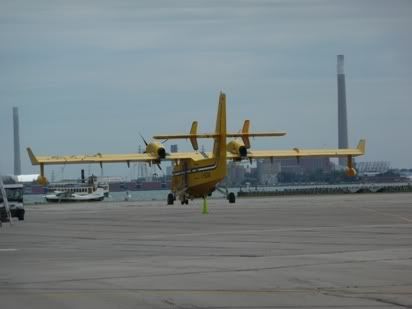
We lined up behind what looked like a Seneca twin and completed power checks. I called ready for departure in turn, but the tower cleared me to line up and jump ahead of the twin (who of course would take longer to do his checks).
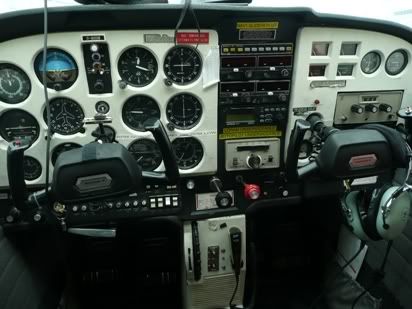
We lined up, powered up and were off. A straight ahead departure as we were already headed in the right direction. I was initially cleared to not above 1500’. I reported level attained and was directed to continue until past the chimneys not above 1500’ as there was a plane towing a glider above. Eventually we saw it as it headed the other way. The tower then cleared us to climb to 2500 and continue en-route.
I switched to Oshawa Tower and followed the Lake Ontario shoreline towards Oshawa. Once clear of Toronto controlled airspace, I climbed to 3500’ with a thin and high overcast at what I would estimate to be 6000’ – no bother at all!
I called Oshawa and advised them that I would be routing through their overhead
I wasn’t sure whether Canada had anything like the US ‘Flight Following’ so I resorted to the ‘UK Method’ of simply independently contacting each major airfield en-route for flight information service. Oshawa seemed busy enough with what sounded like circuit traffic so I called them and advised them out of courtesy that I would be routing through their overhead at 3500’. The weather seemed to be improving with the cloud becoming more broken, then scattered, then lovely bright sunshine with a handful of very scattered ‘good to be alive’ fair weather cumulus.
I stayed with Oshawa for a while, then switched to Trenton. I know that Trenton is a major Canadian Forces Base and that this is where many of the C130’s are based that fly everywhere, including to Alert near the North Pole. I had read up on their procedures and they seemed likely to route me either to the north or the south of the airfield via published VRP’s. Nevertheless, I called them at 30 miles and asked for a transit through their overhead, might as well try to get some nice photos. They gave me a squawk, but couldn’t see me. I called again at 15 miles and they now seemed to see me. They advised that I contact the tower. I asked again for a transit, but the tower routed me via the northern VRP and asked me to report north abeam the airfield at Frankford. Well of course Frankford wasn’t a published reporting point (why do airfields do that – publish VRP’s then not use them but use others that are not published). A quick scan of the map showed the town in question.
I reported at the point and was given another reporting point, this time Foxboro, again not a published VRP. The map showed it easily enough so well and good. At that point they gave me ‘contact en-route frequency’ (i.e. sod-off). So I ‘sodded off’ and tuned into Kingston on 122.50 on listening watch until we got a lot closer.
My original route had me routing north and inland of the town, but looking at the scenery and Lake Ontario and the St Lawrence River, I decided to head south of Kingston just over the water, so I could get some nice photos pointed north away from the glare of the sun. At 15 miles, I called Kingston Tower to advise them that I would route through their overhead at 3500’. They were very quiet and helpful, with one aircraft doing circuits.
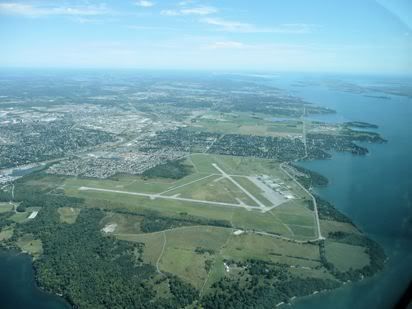
The views were excellent and Kingston looked like a really nice town from the air. We flew over the Royal Military College, set at the tip of a peninsula and over the old Fort Henry built in the 1830’s to protect the entrance to the Rideau Canal from those pesky Americans (who got a pasting from Canadian and British – OK mainly British troops - in the Canadian / US war of 1812).
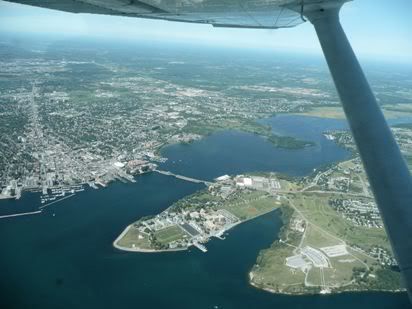
We then routed north but parallel to the St Lawrence looking at the famous ‘thousand islands’ in the St Lawrence. We headed to Brockville, due south or Ottawa and changed to Ottawa Terminal on 127.70. The Ottawa frequency was very busy indeed and I was just about to give my call approaching Brockville when they called what sounded like a slightly wrong version of my callsign asking if it was ‘on frequency’. Given the various jumble of letters I was now used to hearing from US controllers for my callsign, I piped up and asked ‘C-GCOH was that for me’. Well, I guess it wasn’t, but she gave me a ‘C-GCOH pass you message’ anyway. So I ran through the usual format, stated inbound to land and requested joining instructions. She quickly gave me descend and maintain 2500’ and report Manotick. By now it was blazing sunshine with not a trace of cloud in the sky.
I confirmed this then set about asking Dan (who lives in Ottawa) where the hell Manotick was – again using a VRP that was not one of the five published VRP’s – why do people do this? Dan showed me on the map. Apparently a very classy town eight miles south of the airport on the Rideau River. We trundled along listening to a very busy frequency with the lady controller efficiently handling many flights in both English and French (yes, I know that mixed languages in the air is a very bad idea for situational awareness, but such is the ‘dual language’ political correctness prevalent in Canada).
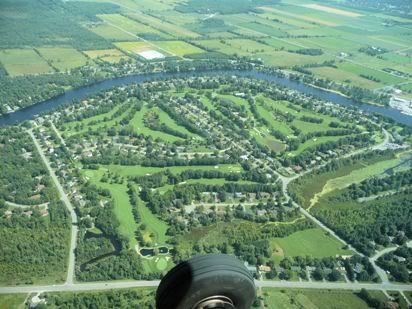
I called at Manotick and she told asked me to do a rate one right hand orbit to allow a commuter Embraer to cross in front coming into one of the main Ottawa commercial runways. I did this and Dan spotted the commuter half way around our turn. I called orbit complete and got a ‘continue’. At three miles she advised me that I was number two into 05 to an Cessna 152 doing circuits and that once I spotted him to slot in behind him.
Well I was still at 2500’, then Dan spotted the C152 which seemed to be doing pretty wide circuits. I did managed to slot in behind him, but now had to slow the plane down a lot and lose height fast. Throttle to idle, check speed, flaps to near full, some throttle back in and sideslip like hell! We were coming down fast now and while not gaining, still close-ish to the 152, but as they were doing circuits, we should be OK as they would be off and away as we were flaring.
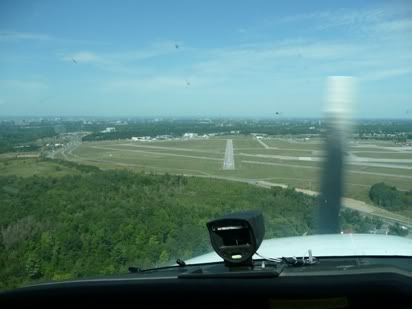
So I continued and had to keep full sideslip on until short final, where I unwound it for a normal short final approach. We flared, touched and rolled without use of brakes to the taxiway at the end of the runway to exit left and do the after landings.
We were down and back! I pulled in to parking and shut down. Dan bustled about efficiently unloading and doing the tie down while I completed the journey log and got my pilot stuff together.
We were down and back by 14:00ish. I wandered back to reception and had Agata help me complete their impressive computerised system while she worked out the fuel refunds I was due from the receipt (their policy is to still use their wet rate, but to give me credit for the amount of fuel I uploaded at their own Ottawa rates – so I would ‘suffer’ any higher rate per litre I paid elsewhere – fair enough I guess).
She told me the final figure and I meekly handed over my now battered Visa card and settled up. In parting, I confirmed with OFC that I would main on their system even though there was no cash credit on my account as I would want to rent from them in future. They seem to be a pretty good outfit, albeit with somewhat tired aircraft (aren’t they all) and very much a busy school, not so much a club. Of course I had to treat myself to an OFC branded polo shirt on the way out.
Well a good final leg to the trip, getting out ahead of the forecast rain which may have cost us a day. We had been remarkably lucky with the weather en-route, but Dan has always said (and I believe him) that the weather is far more stable and predictable in Canada and the US than in the UK.
Logged: 2.4 Hours
Fuel: 80 litres approx
We had an evening and a short morning in Toronto. In the evening we treated ourselves to a superb meal and fine wine at ‘The Keg’ (upmarket restaurant chain) in downtown Toronto. The next morning on checking the weather channel, it was calling for cloudy in the morning and rain in the afternoon. Rather than risk getting ‘stuck’ into Toronto by sticking with the original schedule, we decided to have a quick whip around the ‘Hockey Hall of Fame’ as early as we could then hot foot it over to the City Airport and make it out before midday.

This is how it turned out. I was a bit miffed that the Hockey Hall of Fame didn’t open until 0930, but there it is, we managed to have a look and buy a few souvenirs. We got the free ferry to the island and wandered around to the handling office. I did the flight planning with the equally wonderful Canadian equivalent of WX BRIEF, in this case 1-866-WX BRIEF. Got the weather, NOTAM’s and lodged a flight plan.
Dan headed out to the plane to untie it, pack it and do the A-check, while I settled up at the desk. Well, this was by far the most expensive of the whole trip, with handling and landing fees coming out at $CAN35 - about £18 - what I would pay for a single landing at Gloucester.
They were very helpful on reception and a talkative mechanic wandered by and told me that because of the airshow due that weekend (Canadian and USA Labor Day), there was a Spitfire in the hangar. Of course I just had to have a look on the way out.

There was also a nice line-up of yellow Harvard trainers on the pan.

Dan had done a good job and I just checked the oil and fuel. Full to the gunnels, we mounted up and started up. I got the ATIS and called for taxi. Again we were given 08 as the active runway, but with a bit of a crosswind, though not much to write home about (one becomes very blasé about crosswinds in a nosewheel aircraft!).

We lined up behind what looked like a Seneca twin and completed power checks. I called ready for departure in turn, but the tower cleared me to line up and jump ahead of the twin (who of course would take longer to do his checks).

We lined up, powered up and were off. A straight ahead departure as we were already headed in the right direction. I was initially cleared to not above 1500’. I reported level attained and was directed to continue until past the chimneys not above 1500’ as there was a plane towing a glider above. Eventually we saw it as it headed the other way. The tower then cleared us to climb to 2500 and continue en-route.
I switched to Oshawa Tower and followed the Lake Ontario shoreline towards Oshawa. Once clear of Toronto controlled airspace, I climbed to 3500’ with a thin and high overcast at what I would estimate to be 6000’ – no bother at all!
I called Oshawa and advised them that I would be routing through their overhead
I wasn’t sure whether Canada had anything like the US ‘Flight Following’ so I resorted to the ‘UK Method’ of simply independently contacting each major airfield en-route for flight information service. Oshawa seemed busy enough with what sounded like circuit traffic so I called them and advised them out of courtesy that I would be routing through their overhead at 3500’. The weather seemed to be improving with the cloud becoming more broken, then scattered, then lovely bright sunshine with a handful of very scattered ‘good to be alive’ fair weather cumulus.
I stayed with Oshawa for a while, then switched to Trenton. I know that Trenton is a major Canadian Forces Base and that this is where many of the C130’s are based that fly everywhere, including to Alert near the North Pole. I had read up on their procedures and they seemed likely to route me either to the north or the south of the airfield via published VRP’s. Nevertheless, I called them at 30 miles and asked for a transit through their overhead, might as well try to get some nice photos. They gave me a squawk, but couldn’t see me. I called again at 15 miles and they now seemed to see me. They advised that I contact the tower. I asked again for a transit, but the tower routed me via the northern VRP and asked me to report north abeam the airfield at Frankford. Well of course Frankford wasn’t a published reporting point (why do airfields do that – publish VRP’s then not use them but use others that are not published). A quick scan of the map showed the town in question.
I reported at the point and was given another reporting point, this time Foxboro, again not a published VRP. The map showed it easily enough so well and good. At that point they gave me ‘contact en-route frequency’ (i.e. sod-off). So I ‘sodded off’ and tuned into Kingston on 122.50 on listening watch until we got a lot closer.
My original route had me routing north and inland of the town, but looking at the scenery and Lake Ontario and the St Lawrence River, I decided to head south of Kingston just over the water, so I could get some nice photos pointed north away from the glare of the sun. At 15 miles, I called Kingston Tower to advise them that I would route through their overhead at 3500’. They were very quiet and helpful, with one aircraft doing circuits.

The views were excellent and Kingston looked like a really nice town from the air. We flew over the Royal Military College, set at the tip of a peninsula and over the old Fort Henry built in the 1830’s to protect the entrance to the Rideau Canal from those pesky Americans (who got a pasting from Canadian and British – OK mainly British troops - in the Canadian / US war of 1812).

We then routed north but parallel to the St Lawrence looking at the famous ‘thousand islands’ in the St Lawrence. We headed to Brockville, due south or Ottawa and changed to Ottawa Terminal on 127.70. The Ottawa frequency was very busy indeed and I was just about to give my call approaching Brockville when they called what sounded like a slightly wrong version of my callsign asking if it was ‘on frequency’. Given the various jumble of letters I was now used to hearing from US controllers for my callsign, I piped up and asked ‘C-GCOH was that for me’. Well, I guess it wasn’t, but she gave me a ‘C-GCOH pass you message’ anyway. So I ran through the usual format, stated inbound to land and requested joining instructions. She quickly gave me descend and maintain 2500’ and report Manotick. By now it was blazing sunshine with not a trace of cloud in the sky.
I confirmed this then set about asking Dan (who lives in Ottawa) where the hell Manotick was – again using a VRP that was not one of the five published VRP’s – why do people do this? Dan showed me on the map. Apparently a very classy town eight miles south of the airport on the Rideau River. We trundled along listening to a very busy frequency with the lady controller efficiently handling many flights in both English and French (yes, I know that mixed languages in the air is a very bad idea for situational awareness, but such is the ‘dual language’ political correctness prevalent in Canada).

I called at Manotick and she told asked me to do a rate one right hand orbit to allow a commuter Embraer to cross in front coming into one of the main Ottawa commercial runways. I did this and Dan spotted the commuter half way around our turn. I called orbit complete and got a ‘continue’. At three miles she advised me that I was number two into 05 to an Cessna 152 doing circuits and that once I spotted him to slot in behind him.
Well I was still at 2500’, then Dan spotted the C152 which seemed to be doing pretty wide circuits. I did managed to slot in behind him, but now had to slow the plane down a lot and lose height fast. Throttle to idle, check speed, flaps to near full, some throttle back in and sideslip like hell! We were coming down fast now and while not gaining, still close-ish to the 152, but as they were doing circuits, we should be OK as they would be off and away as we were flaring.

So I continued and had to keep full sideslip on until short final, where I unwound it for a normal short final approach. We flared, touched and rolled without use of brakes to the taxiway at the end of the runway to exit left and do the after landings.
We were down and back! I pulled in to parking and shut down. Dan bustled about efficiently unloading and doing the tie down while I completed the journey log and got my pilot stuff together.
We were down and back by 14:00ish. I wandered back to reception and had Agata help me complete their impressive computerised system while she worked out the fuel refunds I was due from the receipt (their policy is to still use their wet rate, but to give me credit for the amount of fuel I uploaded at their own Ottawa rates – so I would ‘suffer’ any higher rate per litre I paid elsewhere – fair enough I guess).
She told me the final figure and I meekly handed over my now battered Visa card and settled up. In parting, I confirmed with OFC that I would main on their system even though there was no cash credit on my account as I would want to rent from them in future. They seem to be a pretty good outfit, albeit with somewhat tired aircraft (aren’t they all) and very much a busy school, not so much a club. Of course I had to treat myself to an OFC branded polo shirt on the way out.
Well a good final leg to the trip, getting out ahead of the forecast rain which may have cost us a day. We had been remarkably lucky with the weather en-route, but Dan has always said (and I believe him) that the weather is far more stable and predictable in Canada and the US than in the UK.
CAN/USA: Niagara Intl to Toronto City
Route: KIAG (Niagara International) DCT Niagara Falls DCT Niagara on the Lake DCT St Catherines DCT Hamilton DCT CYTZ (Toronto City)
Logged: 2.8 Hrs
Fuel: 41.2 litres
The first thing I had to do once I landed at Niagara for the next leg was to book Canadian customs. This is similar but easier than booking US customs. There is one number, 1-866-CANPASS. You call this, tell them where and when, then you must arrive 30 minutes either side of the quoted time. You can’t get out of the aircraft before the time, but after that if they haven’t shown up, call them again to get a clearance number and the inspectors badge number. You must give them between two and twenty-four hours notice.
So I called 1-866-CANPASS. They asked me about the where and when. I was planning to land at Toronto City airport (on centre island right in the heart of the city). I did this with the required two hours notice (one hour to turnaround at Niagara and one hour en-route). He asked if we bought anything in New York that we were now bringing back. I thought about this carefully and took him at his word – ‘anything’ – assuming he didn’t really mean ‘anything’. So I thought about it and asked Dan. Dan recalled that he bought three New York branded baseball hats for an extravagant $US4 each in Chinatown. As a laugh, I told the customs officer who to my surprise seemed to note this carefully and asked if we bought anything else. No that was it. I thought no more about it as he confirmed our slot was booked.
I finished flight planning using the wonderful 1-800-WX BRIEF. Dan had gone for light refreshment so I checked back at the counter. I couldn’t see anyone fuelling the aircraft, so asked them again explaining that I was on a quick turnaround. ‘Oh, it’s all done’ they said cheerfully. I explained that I was asking if it had been refuelled yet or not, as I couldn’t believe that it could be done so fast. ‘Oh yes, all done’ they replied. I could hardly believe it – so fast? I went outside to check and sure enough, fully fuelled. WOW!
I started arranging my kneeboard with the route plan and charts I would need for the next leg and filing the previous legs charts when Dan re-appeared with generous take-away sandwiches. So we both stood there on the apron cramming them in as I checked the plane for flight.
I went back to the handling service to settle the bill. The bill for handling and landing fee? $US3.00! They even apologised for charging this explaining that they were compelled to by the airport – I laughed and explained that I wished that was all I had to pay in the UK.
We mounted up at the appointed time and called ready for taxi. We were given the same runway for departure (runway 10R). I taxied but got confused by the taxiways and accidentally crossed the holding point as it was so near. I stopped and asked for confirmation of the holding point and had I crossed it? They simply asked me to do a 180 and line up at the board behind me. Well, I guess that was my mistake for this flight (I always seem to make one).
Power checks complete I called ready for departure and was given clearance for a left turnout climbing to 3500’ for the Niagara Falls sightseeing pattern. Off we went with a gradual climbing turn, aiming to reach 3500’ before reaching Navy Island in the Niagara River, one of the VRP’s acting as the start point to join the ‘racetrack’ pattern over Niagara Falls.
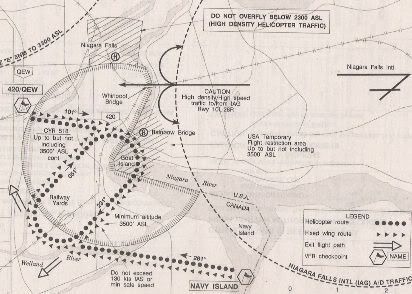
I changed frequency from the Tower to 122.05, the self-announcing frequency for the Niagara Falls pattern. I called at Navy Island as we followed the bearing for the railway marshalling yard which formed the SW end of the racetrack which then went clockwise behind and in front of the falls.
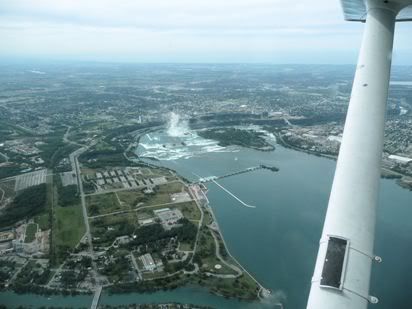
We made all of the appropriate position announcements and heard several helicopters doing the same, no other fixed wing traffic. We did spot one helicopter a couple of hundred feet below us, but the others seemed to be far below – quite what they knew that I didn’t about the ‘not below 3500 feet’ part of the restrictions baffled me and not for the first time did I conclude that published restrictions did not apply to helicopters (although 3500’ did seem extreme to me given that they are quite happy with you bumbling around downtown New York at 1100’!).
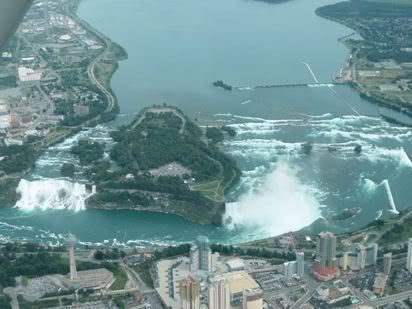
We did two trips around the pattern at Niagara Falls before self-announcing our departure on the NE leg direct to Niagara on the Lake for the border crossing into Canada.
I switched to the local St Catherine’s Airfield frequency and let them know I would be routing near their overhead at 3500’. Basically, the plan was to route clockwise around the shores of Lake Ontario to Toronto City airport. We could have gone straight across and I could see the other side, a mere 26 nm - farther than the 'short channel crossing', but not by much. But as we didn’t have either liferaft or lifejackets, I decided to stick with the shore.
Passed St Catherine’s, I switched to Toronto Centre on 133.40, advised them of our plan and got FIS from them. The weather was OK, not sunny now, but the broken cloud was thin and high and no constraint. The Toronto advised me of opposite direction traffic at my 11 o’clock at the same height and 4 miles. A quick glance and we couldn’t see it. So I announced that I was descending to 3000’ and turned on the landing lights. I heard the opposite direction traffic call visual, but we never saw him.
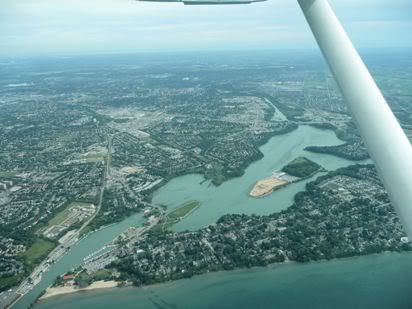
We carried on past the rather nice looking St Catherine’s to the rather unlovely Hamilton.
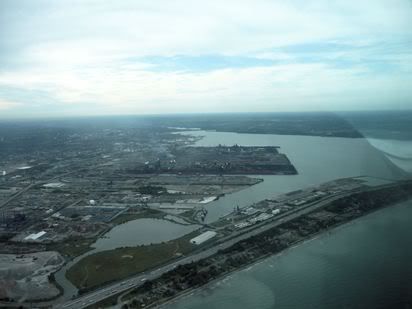
Again, opposite direction traffic at 12 o’clock, this time 500’ below. So check altitude and sharp lookout. Again, we didn’t see them. About 40 miles to run I asked for descent to 2500’ and Toronto Centre agreed. I asked if they wanted me to continue descending to remain clear of their steeped descending airspace, but they said no, to continue at 2500’ until they released me to Toronto City.
We could see the city skyline in the distance as we continued. At about ten miles Toronto Centre advised us to contact City Tower on 118.20. They advised us that runway 08 was in use and the wind was 080/10G15. OK, straight down the runway, so no problem there. The plates said to avoid over-flight of Ontario Place, which we would normally do for a long final on this runway, so I tried for an angled approach to avoid this noise sensitive area.
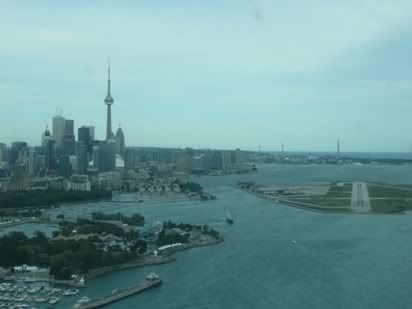
Two mile final and cleared to land. The approach was good as we touched down. I hit one of the rudder pedals by mistake and pulled the plane a bit to the right, then corrected with some left – come on Steve, start thinking! We exited left and were told to taxi to Porter who are the utterly dominant FBO at the airport (a Canadian commuter airline). I pulled in next to another Cessna in what looked like a parking space and switched off. I was ten minutes early, so although I opened the window, we stayed sat in the plane.
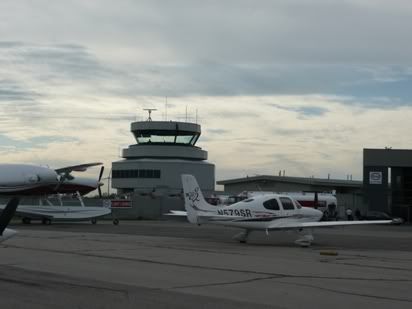
Five minutes before the customs time, a guy walked up and said we couldn’t park there as it was part of the manoeuvring apron. He was right, although there were holes for tie-downs, they had been tarmac’d over – Ooops! As we spoke, I saw another Cessna ull forward out of a crowded flight line, so I started up and headed for there.
By the time we got there and shutdown, it was the stated arrival time, so I got out and started to unpack. Dan tied the aircraft down. Still no customs, so Dan and I started walking to what looked like the main passenger terminal. We were intercepted by an airport security van who asked us why we were walking airside. I explained and he ushered us into the van and said if customs didn’t show up that we should call them for specific clearance as they probably weren’t here at all and often didn’t show up.
OK, so I called them on 1-866-CANPASS. He asked if we had anything to declare and I said no. There was an ominous pause on the line as he said ‘you earlier declared that you were in possession of baseball hats, are you still in possession of these items?’. OK, OK, you got me! I forgot all about the baseball hats worth $US12! I said sorry, that I forgot about those and I got the now standard ‘I see’. He then cleared us and gave us a customs clearance number and his badge number which he advised us to note on the flight log and carry on us personally in case questioned by customs when leaving or arriving in Canada at another time. So I noted it on both the Journey Log and in my pilots logbook.
I realised that I was now a bit tired. While this was not the most number of hours I have flown in a day, it has been tiring, especially the New York low level route, where I was far from relaxed with all the traffic about.
We headed towards the building to the left of the main Porter hangar where I had seen people going to and fro. This was the main entrance to the Porter helicopter facility and acted as handling for GA. The lady on the desk was extremely bright and helpful and agreed to refuel. She said the courtesy van had now knocked off for the night and if we were OK with it, could we walk the 200m to the dock where we could get the free ferry to downtown Toronto, where once we got off, we could get the free bus to Union Station (very near our hotel). OK, so far I like all this free stuff!.
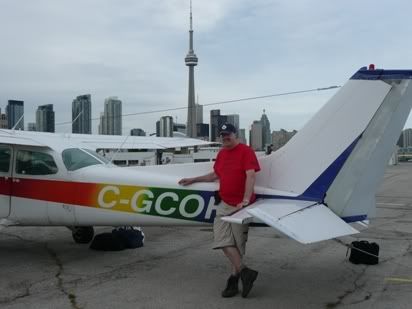
Well, that was it. We had arrived. I felt immediately at home with the impressive Toronto skyline. This is where I was born and raised and despite my many years in England, this still feels like my real home.
An easy flight with a pretty clear procedure for seeing the falls themselves, if a bit too high for my liking. Toronto City has to be one of the best and most scenic city airports there is anywhere in the world. I seriously recommend this particular airport to anyone.
Logged: 2.8 Hrs
Fuel: 41.2 litres
The first thing I had to do once I landed at Niagara for the next leg was to book Canadian customs. This is similar but easier than booking US customs. There is one number, 1-866-CANPASS. You call this, tell them where and when, then you must arrive 30 minutes either side of the quoted time. You can’t get out of the aircraft before the time, but after that if they haven’t shown up, call them again to get a clearance number and the inspectors badge number. You must give them between two and twenty-four hours notice.
So I called 1-866-CANPASS. They asked me about the where and when. I was planning to land at Toronto City airport (on centre island right in the heart of the city). I did this with the required two hours notice (one hour to turnaround at Niagara and one hour en-route). He asked if we bought anything in New York that we were now bringing back. I thought about this carefully and took him at his word – ‘anything’ – assuming he didn’t really mean ‘anything’. So I thought about it and asked Dan. Dan recalled that he bought three New York branded baseball hats for an extravagant $US4 each in Chinatown. As a laugh, I told the customs officer who to my surprise seemed to note this carefully and asked if we bought anything else. No that was it. I thought no more about it as he confirmed our slot was booked.
I finished flight planning using the wonderful 1-800-WX BRIEF. Dan had gone for light refreshment so I checked back at the counter. I couldn’t see anyone fuelling the aircraft, so asked them again explaining that I was on a quick turnaround. ‘Oh, it’s all done’ they said cheerfully. I explained that I was asking if it had been refuelled yet or not, as I couldn’t believe that it could be done so fast. ‘Oh yes, all done’ they replied. I could hardly believe it – so fast? I went outside to check and sure enough, fully fuelled. WOW!
I started arranging my kneeboard with the route plan and charts I would need for the next leg and filing the previous legs charts when Dan re-appeared with generous take-away sandwiches. So we both stood there on the apron cramming them in as I checked the plane for flight.
I went back to the handling service to settle the bill. The bill for handling and landing fee? $US3.00! They even apologised for charging this explaining that they were compelled to by the airport – I laughed and explained that I wished that was all I had to pay in the UK.
We mounted up at the appointed time and called ready for taxi. We were given the same runway for departure (runway 10R). I taxied but got confused by the taxiways and accidentally crossed the holding point as it was so near. I stopped and asked for confirmation of the holding point and had I crossed it? They simply asked me to do a 180 and line up at the board behind me. Well, I guess that was my mistake for this flight (I always seem to make one).
Power checks complete I called ready for departure and was given clearance for a left turnout climbing to 3500’ for the Niagara Falls sightseeing pattern. Off we went with a gradual climbing turn, aiming to reach 3500’ before reaching Navy Island in the Niagara River, one of the VRP’s acting as the start point to join the ‘racetrack’ pattern over Niagara Falls.

I changed frequency from the Tower to 122.05, the self-announcing frequency for the Niagara Falls pattern. I called at Navy Island as we followed the bearing for the railway marshalling yard which formed the SW end of the racetrack which then went clockwise behind and in front of the falls.

We made all of the appropriate position announcements and heard several helicopters doing the same, no other fixed wing traffic. We did spot one helicopter a couple of hundred feet below us, but the others seemed to be far below – quite what they knew that I didn’t about the ‘not below 3500 feet’ part of the restrictions baffled me and not for the first time did I conclude that published restrictions did not apply to helicopters (although 3500’ did seem extreme to me given that they are quite happy with you bumbling around downtown New York at 1100’!).

We did two trips around the pattern at Niagara Falls before self-announcing our departure on the NE leg direct to Niagara on the Lake for the border crossing into Canada.
I switched to the local St Catherine’s Airfield frequency and let them know I would be routing near their overhead at 3500’. Basically, the plan was to route clockwise around the shores of Lake Ontario to Toronto City airport. We could have gone straight across and I could see the other side, a mere 26 nm - farther than the 'short channel crossing', but not by much. But as we didn’t have either liferaft or lifejackets, I decided to stick with the shore.
Passed St Catherine’s, I switched to Toronto Centre on 133.40, advised them of our plan and got FIS from them. The weather was OK, not sunny now, but the broken cloud was thin and high and no constraint. The Toronto advised me of opposite direction traffic at my 11 o’clock at the same height and 4 miles. A quick glance and we couldn’t see it. So I announced that I was descending to 3000’ and turned on the landing lights. I heard the opposite direction traffic call visual, but we never saw him.

We carried on past the rather nice looking St Catherine’s to the rather unlovely Hamilton.

Again, opposite direction traffic at 12 o’clock, this time 500’ below. So check altitude and sharp lookout. Again, we didn’t see them. About 40 miles to run I asked for descent to 2500’ and Toronto Centre agreed. I asked if they wanted me to continue descending to remain clear of their steeped descending airspace, but they said no, to continue at 2500’ until they released me to Toronto City.
We could see the city skyline in the distance as we continued. At about ten miles Toronto Centre advised us to contact City Tower on 118.20. They advised us that runway 08 was in use and the wind was 080/10G15. OK, straight down the runway, so no problem there. The plates said to avoid over-flight of Ontario Place, which we would normally do for a long final on this runway, so I tried for an angled approach to avoid this noise sensitive area.

Two mile final and cleared to land. The approach was good as we touched down. I hit one of the rudder pedals by mistake and pulled the plane a bit to the right, then corrected with some left – come on Steve, start thinking! We exited left and were told to taxi to Porter who are the utterly dominant FBO at the airport (a Canadian commuter airline). I pulled in next to another Cessna in what looked like a parking space and switched off. I was ten minutes early, so although I opened the window, we stayed sat in the plane.

Five minutes before the customs time, a guy walked up and said we couldn’t park there as it was part of the manoeuvring apron. He was right, although there were holes for tie-downs, they had been tarmac’d over – Ooops! As we spoke, I saw another Cessna ull forward out of a crowded flight line, so I started up and headed for there.
By the time we got there and shutdown, it was the stated arrival time, so I got out and started to unpack. Dan tied the aircraft down. Still no customs, so Dan and I started walking to what looked like the main passenger terminal. We were intercepted by an airport security van who asked us why we were walking airside. I explained and he ushered us into the van and said if customs didn’t show up that we should call them for specific clearance as they probably weren’t here at all and often didn’t show up.
OK, so I called them on 1-866-CANPASS. He asked if we had anything to declare and I said no. There was an ominous pause on the line as he said ‘you earlier declared that you were in possession of baseball hats, are you still in possession of these items?’. OK, OK, you got me! I forgot all about the baseball hats worth $US12! I said sorry, that I forgot about those and I got the now standard ‘I see’. He then cleared us and gave us a customs clearance number and his badge number which he advised us to note on the flight log and carry on us personally in case questioned by customs when leaving or arriving in Canada at another time. So I noted it on both the Journey Log and in my pilots logbook.
I realised that I was now a bit tired. While this was not the most number of hours I have flown in a day, it has been tiring, especially the New York low level route, where I was far from relaxed with all the traffic about.
We headed towards the building to the left of the main Porter hangar where I had seen people going to and fro. This was the main entrance to the Porter helicopter facility and acted as handling for GA. The lady on the desk was extremely bright and helpful and agreed to refuel. She said the courtesy van had now knocked off for the night and if we were OK with it, could we walk the 200m to the dock where we could get the free ferry to downtown Toronto, where once we got off, we could get the free bus to Union Station (very near our hotel). OK, so far I like all this free stuff!.

Well, that was it. We had arrived. I felt immediately at home with the impressive Toronto skyline. This is where I was born and raised and despite my many years in England, this still feels like my real home.
An easy flight with a pretty clear procedure for seeing the falls themselves, if a bit too high for my liking. Toronto City has to be one of the best and most scenic city airports there is anywhere in the world. I seriously recommend this particular airport to anyone.
CAN/USA: Westchester to Niagara Intl
Route: KHPN (Westchester) DCT HUO DCT CFB DCT GEE DCT KIAG (Niagara International)
Logged: 2.8 hours
Fuel: 91 litres
After landing back at Westchester from the New York low level route, I had the plane topped off with fuel and settled the fuel and handling bill with Million Air. I was hoping that they wouldn’t live up to their name and sure enough, the charges were perfectly reasonable – barely more that I would pay for the landing fee alone at Shobdon! A mere $US22.00!
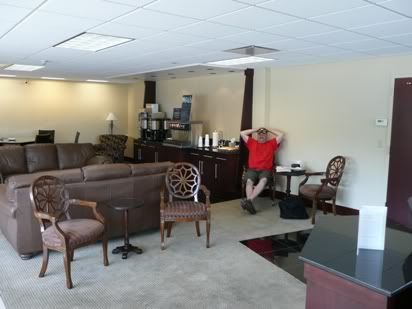
I called the wonderful 1-800-WX BRIEF and got the weather (hardly needed it as it was bright, warm and wonderful sunshine all the way), NOTAM’s (there weren’t any affecting me) and lodged a flight plan.
That settled, we mounted up, got the ATIS and called for taxi on the ground frequency. We were again on runway 16 and after power checks, I switched to tower and was cleared for departure with a right turnout and yes, they would activate my flight plan.
We lined up, powered up and were off again, barely an hour after touching down from the previous flight.
I climbed to the cleared 1500’, levelled out and tried to contact New York Centre. They were very busy indeed. I tried two or three calls asking for flight following but with no reply. Either they didn’t hear me or didn’t bother to reply as it was obvious they didn’t have the capacity.
It was at this point that I noticed that my headset was noisier than usual and a quick check of the battery box for the ANR showed no red light, so my battery had died. I tried to talk to Dan on the intercom, but he couldn’t hear me. Oh great! We carried on at 1500’ until clear of the NY zone now headed North West. I climbed to 2500’ for now and tried to sort out what was happening. Thinking I had radio failure, I tried Flightwatch on 122.0 and asked for a frequency for flight following. They heard me OK and replied, but did not come back with a frequency and didn’t reply to later calls, again either because they didn’t hear me or were ignoring me.
This set me worrying, did I have radio failure and should I turn around? Well, it was clear that people could hear me on the radio and Dan could hear radio transmissions, but my ANR was out as was the intercom – coincidence? I started to think that the failure in ANR was linked and setting up some sort of incompatibility with Dan’s headset and the ancient intercom. I had had an ANR battery die on me before, and all it did was carry on as normal but without ANR. Dan’s headsets were exactly the same as mine (DC 13.4’s) but without the ANR mod.
OK, work the problem. We swapped headsets and that didn’t do anything. I had Dan change the battery for a spare I had in the flight bag, but that too was dead. I know I had had it a fair while, but why would an unused battery be dead? I checked the circuit breakers and even recycled the alternator – no change.
I climbed to my cruise of 4500’ following the US quadrantal rule. Having spent a joyful 20 minutes or so trying to resolve the problem, I came to the conclusion that the intercom had failed but that I had radio contact, so no need for a divert. I still didn’t have flight following, so I checked the map for the nearest large airport.
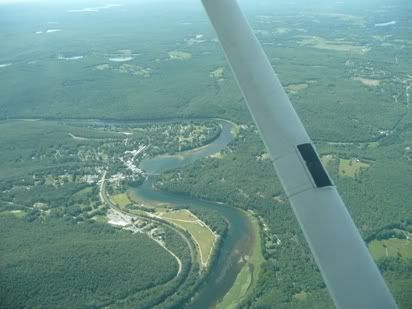
I discovered Wilkes-Barre / Scranton and called them on 120.10 asking for flight following. They responded immediately and allocated a squawk and flight following – well at least something is now going right!
Despite my 4500’, the ground seemed mighty close on occasions, a fact confirmed by the contour colouring on the map, this was high by gently rolling countryside, alternately thickly forested with large clearer famed areas with scattered settlements.
We continued on, learning the lost art of mime to converse with each other. Well, at least the flight following was working well as I was handed on from Wilkes-Barre to Binghampton to Elmira.
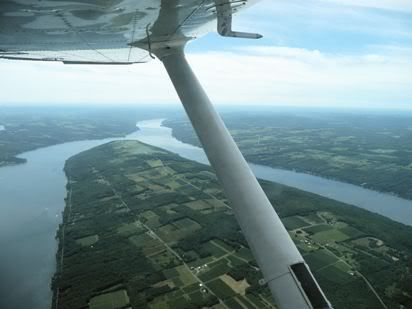
As I was approaching the GEE VOR, I was given a traffic advisory of an aircraft at the same altitude orbiting over the VOR and I was advised to turn south immediately. Well the work ‘immediate’ grabbed my attention as I cranked it around before I even acknowledged the transmission. I continued south until I was advised I was well clear of the traffic and resumed course for Niagara.
It was at this point that I dropped my pen. In leaning over to pick it up, I noticed a very small panel on the lower centre console with two buttons on it that had previously been hidden from my view by the yoke. Hmmmm I thought – its got one of those very old hand held mikes attached to it……..YOU IDIOT! This was the elusive intercom control panel. Why I hadn’t noticed it before I will never know. Looking at it carefully I saw a small flick switch marked ‘Isol / All’. It was set to ‘Isol’. I wonder what will happen if I flick it to ‘All’. You guessed it, the intercom came to life! I even managed to adjust the squelch and volume setting so that the intercom was louder than the radio so we could hear each other without being blasted out by radio transmissions.
Well I had to confess my idiocy to Dan. Where the intercom controls were placed was right next to the trim wheel and I had obviously knocked the switch onto ‘Isolate’ when trimming the plane in the climbout from Westchester! In my defence, I would point out that the plane had a lot of instruments fitted, but many were noted as unserviceable, so it was a case of ‘can’t see the forest for the trees’.
So as it turned out, the failure of my ANR battery was pure coincidence. I suppose that on the plus side, I didn’t let it distract me too much while we were relatively low and in busy airspace. Well, that was my mistake for this particular leg and a very good one at that!
We continued on as I got over my stupidity and were transferred to Rochester and then onto Buffalo Centre on 126.15. Buffalo were great and clearly had time on their hands as they vectored me (not that I needed it) onto the right downwind approach for 10 Right at Niagara International. At 5 miles I changed to Niagara Tower on 118.50.
Niagara International is one of those American airports that is part USAF (Air National Guard) and part civilian. So one runway was HUGE (10,000') and the other was a more normal civilian size (4,000') with both parallel to each other, hence the necessary L and R designations.
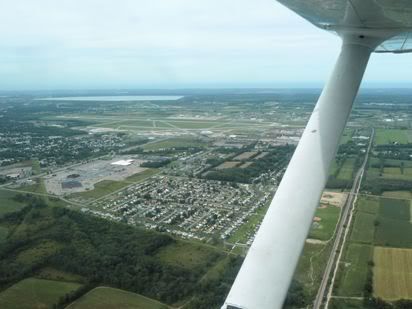
I descended to circuit height and came in on the downwind leg. I was cleared to land and put her down nicely on the threshold. I was given a ‘next right’ exit and pointed towards the local FBO called Tech Aviation.
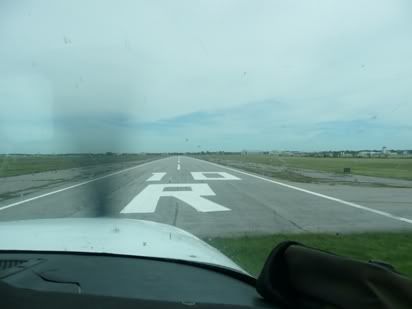
We taxied in and shut down. I wandered over to the handling agent and was met by a friendly and casual lady behind the desk. I asked for the plane to be gassed up and that we were looking for a quick turnaround. She pointed me at the flight planning room down the corridor and directed Dan to a diner across the road as he hadn’t eaten any lunch and he does not fit in with my pattern of a big breakfast and no lunch. She also indicated that the tower will already have closed the flight plan for me.
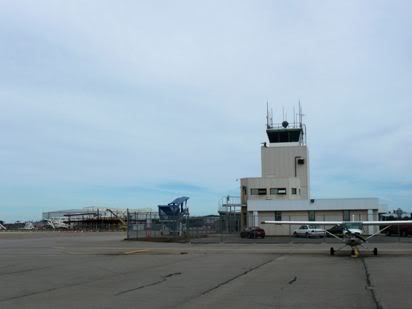
I grabbed a few sweets on display on the counter and headed for the flight planning room as Dan headed for the diner.
An easy trip in excellent weather that went off very much as planned except again for some initial difficulty in picking up flight forwarding and of course my debacle with the headset and intercom. Flying in the US is remarkably simple, cheap and easy compared to the crowded airspace, expensive handling and onerous radio work associated with the UK.
Logged: 2.8 hours
Fuel: 91 litres
After landing back at Westchester from the New York low level route, I had the plane topped off with fuel and settled the fuel and handling bill with Million Air. I was hoping that they wouldn’t live up to their name and sure enough, the charges were perfectly reasonable – barely more that I would pay for the landing fee alone at Shobdon! A mere $US22.00!

I called the wonderful 1-800-WX BRIEF and got the weather (hardly needed it as it was bright, warm and wonderful sunshine all the way), NOTAM’s (there weren’t any affecting me) and lodged a flight plan.
That settled, we mounted up, got the ATIS and called for taxi on the ground frequency. We were again on runway 16 and after power checks, I switched to tower and was cleared for departure with a right turnout and yes, they would activate my flight plan.
We lined up, powered up and were off again, barely an hour after touching down from the previous flight.
I climbed to the cleared 1500’, levelled out and tried to contact New York Centre. They were very busy indeed. I tried two or three calls asking for flight following but with no reply. Either they didn’t hear me or didn’t bother to reply as it was obvious they didn’t have the capacity.
It was at this point that I noticed that my headset was noisier than usual and a quick check of the battery box for the ANR showed no red light, so my battery had died. I tried to talk to Dan on the intercom, but he couldn’t hear me. Oh great! We carried on at 1500’ until clear of the NY zone now headed North West. I climbed to 2500’ for now and tried to sort out what was happening. Thinking I had radio failure, I tried Flightwatch on 122.0 and asked for a frequency for flight following. They heard me OK and replied, but did not come back with a frequency and didn’t reply to later calls, again either because they didn’t hear me or were ignoring me.
This set me worrying, did I have radio failure and should I turn around? Well, it was clear that people could hear me on the radio and Dan could hear radio transmissions, but my ANR was out as was the intercom – coincidence? I started to think that the failure in ANR was linked and setting up some sort of incompatibility with Dan’s headset and the ancient intercom. I had had an ANR battery die on me before, and all it did was carry on as normal but without ANR. Dan’s headsets were exactly the same as mine (DC 13.4’s) but without the ANR mod.
OK, work the problem. We swapped headsets and that didn’t do anything. I had Dan change the battery for a spare I had in the flight bag, but that too was dead. I know I had had it a fair while, but why would an unused battery be dead? I checked the circuit breakers and even recycled the alternator – no change.
I climbed to my cruise of 4500’ following the US quadrantal rule. Having spent a joyful 20 minutes or so trying to resolve the problem, I came to the conclusion that the intercom had failed but that I had radio contact, so no need for a divert. I still didn’t have flight following, so I checked the map for the nearest large airport.

I discovered Wilkes-Barre / Scranton and called them on 120.10 asking for flight following. They responded immediately and allocated a squawk and flight following – well at least something is now going right!
Despite my 4500’, the ground seemed mighty close on occasions, a fact confirmed by the contour colouring on the map, this was high by gently rolling countryside, alternately thickly forested with large clearer famed areas with scattered settlements.
We continued on, learning the lost art of mime to converse with each other. Well, at least the flight following was working well as I was handed on from Wilkes-Barre to Binghampton to Elmira.

As I was approaching the GEE VOR, I was given a traffic advisory of an aircraft at the same altitude orbiting over the VOR and I was advised to turn south immediately. Well the work ‘immediate’ grabbed my attention as I cranked it around before I even acknowledged the transmission. I continued south until I was advised I was well clear of the traffic and resumed course for Niagara.
It was at this point that I dropped my pen. In leaning over to pick it up, I noticed a very small panel on the lower centre console with two buttons on it that had previously been hidden from my view by the yoke. Hmmmm I thought – its got one of those very old hand held mikes attached to it……..YOU IDIOT! This was the elusive intercom control panel. Why I hadn’t noticed it before I will never know. Looking at it carefully I saw a small flick switch marked ‘Isol / All’. It was set to ‘Isol’. I wonder what will happen if I flick it to ‘All’. You guessed it, the intercom came to life! I even managed to adjust the squelch and volume setting so that the intercom was louder than the radio so we could hear each other without being blasted out by radio transmissions.
Well I had to confess my idiocy to Dan. Where the intercom controls were placed was right next to the trim wheel and I had obviously knocked the switch onto ‘Isolate’ when trimming the plane in the climbout from Westchester! In my defence, I would point out that the plane had a lot of instruments fitted, but many were noted as unserviceable, so it was a case of ‘can’t see the forest for the trees’.
So as it turned out, the failure of my ANR battery was pure coincidence. I suppose that on the plus side, I didn’t let it distract me too much while we were relatively low and in busy airspace. Well, that was my mistake for this particular leg and a very good one at that!
We continued on as I got over my stupidity and were transferred to Rochester and then onto Buffalo Centre on 126.15. Buffalo were great and clearly had time on their hands as they vectored me (not that I needed it) onto the right downwind approach for 10 Right at Niagara International. At 5 miles I changed to Niagara Tower on 118.50.
Niagara International is one of those American airports that is part USAF (Air National Guard) and part civilian. So one runway was HUGE (10,000') and the other was a more normal civilian size (4,000') with both parallel to each other, hence the necessary L and R designations.

I descended to circuit height and came in on the downwind leg. I was cleared to land and put her down nicely on the threshold. I was given a ‘next right’ exit and pointed towards the local FBO called Tech Aviation.

We taxied in and shut down. I wandered over to the handling agent and was met by a friendly and casual lady behind the desk. I asked for the plane to be gassed up and that we were looking for a quick turnaround. She pointed me at the flight planning room down the corridor and directed Dan to a diner across the road as he hadn’t eaten any lunch and he does not fit in with my pattern of a big breakfast and no lunch. She also indicated that the tower will already have closed the flight plan for me.

I grabbed a few sweets on display on the counter and headed for the flight planning room as Dan headed for the diner.
An easy trip in excellent weather that went off very much as planned except again for some initial difficulty in picking up flight forwarding and of course my debacle with the headset and intercom. Flying in the US is remarkably simple, cheap and easy compared to the crowded airspace, expensive handling and onerous radio work associated with the UK.
CAN/USA: New York City Route
Route: KHPN (Westchester) DCT Tappensee Bridge DCT Manhattan DCT Tappensee Bridge DCT KHPN
Logged: 1.1 hours
Fuel: 41.5 litres
After staying in downtown New York for two nights and being shown the sights by my sister (who now lives in New York), we returned to Westchester via the commuter train to White Plains and a pick-up by Million Air, our flight handling service.
I spoke to the Million Air reception about the bill and explained that I was going on a ‘local’ around the NY low-level route and would return to Westchester for a fuel top up and would prefer to pay then. They were fine with this and confirmed that it had already been fully refuelled.
I got some helpful advice on the route from a local pilot, who confirmed what I already knew. Basically not above 1500’, but with some sections not above 1100’ (so I decided to stick with 1100’ for the whole route). South down the Hudson river following the west (right) side of the river. Self announce position reports on the specific frequency for the low level route of 123.05. Then around Ellis and Liberty Islands, back over Governors Island, quick peek at the East River, then hard left around Battery Park and back up the Hudson on the east side (right) flying past Manhattan, Greenwich Village, Central Park etc and back up to the Tappensee Bridge, then inland back to Westchester.
We wandered out and Dan prepped and packed the aircraft. We were good to go so we mounted up and I called Westchester Ground for taxi. I was instructed to taxi to the hold for runway 16.
I did the power checks and switched to Tower and called ready. They gave me a right turnout departure not above 1500'. So off we went.
I had not programmed anything in on the GPS and there were no radio beacons of any use, so I flew by map, time and compass bearing direct to the Tappensee Bridge, some 30 nautical miles up the Hudson River from Manhattan. This was not much of a navigational challenge as I only had to head west for 10 nm before I picked up the Hudson running North / South and you can hardly mistake the Hudson!
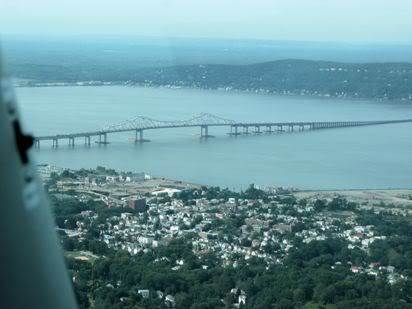
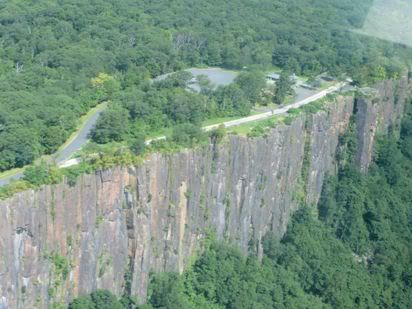
We hit the Tappensee Bridge pretty much spot on and proceeded down the Hudson river on the right hand side (western side), but still over the river itself. I changed frequency to 123.05 and started self-announcing. The frequency seemed full of others doing the same. All of the other aircraft seemed very well versed and slick in their calls and used all sorts of locations not marked on the map, so I immediately realised I was dealing with the professional helicopter jocks who I saw plying the low level route in their droves while on the ground in NY.
We plodded along at our stately 105kts as the skyline of NY hove into view with the also imposing New Jersey skyline on the near shore I was flying. It looked far more impressive in the early morning haze than photographs can possibly do justice to. I turned on every light and beacon I had and hoped that ’see and avoid’ worked both ways!
I called over the Holland Tunnel, took a deep breath, and plunged into the really busy part of the pattern. I kept a sharp lookout for traffic and maintained situational awareness while Dan snapped happily away with the camera.
We passed very close to a particularly tall New Jersey skyscraper outbound to Ellis and Liberty Islands.
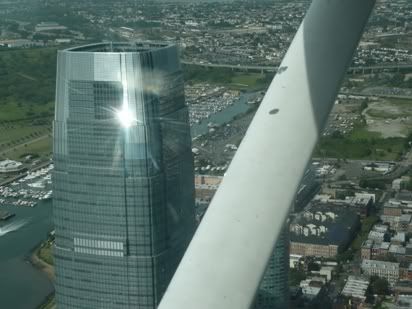
On the way to them, I came across two helicopters, one above me (surely in controlled airspace?) and one below. I was sure we saw each other, so continued and passed vertically between them like a sandwich – it probably sounds more dramatic than it was as there was always a couple of hundred feet between us. Any other day, I might have been worried, but I suspected that this was ‘just another Wednesday’ on the NY low level route.
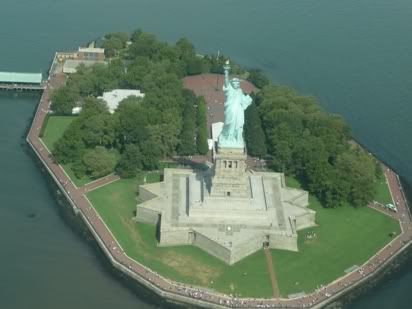
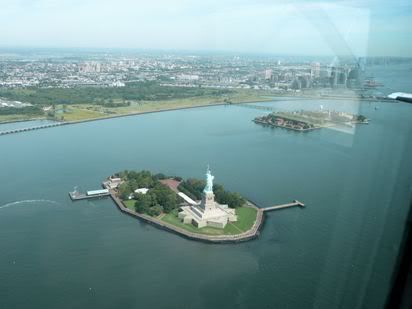
I turned left around Liberty Island with the iconic status of liberty and headed for Governors Island on the way to the East River. I only went far enough up the East River to check out the Brooklyn Bridge, then hauled the plane around into moderate left-hander to pass in front of Battery Park at the southern tip of Manhattan. Now we got some really ‘up close and personal’ photos of skyscrapers!
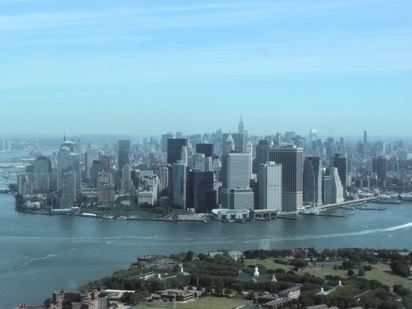
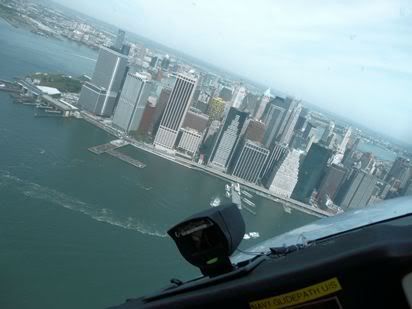
I was now on the right hand side (east) of the Hudson, over water of course and headed back up north. This was still a busy stretch but the worst was passed. I was still very busy flying the plane and keeping a lookout, but did managed some glances at the scenery – this isn’t the place for a relaxed and carefree bimble I can tell you!
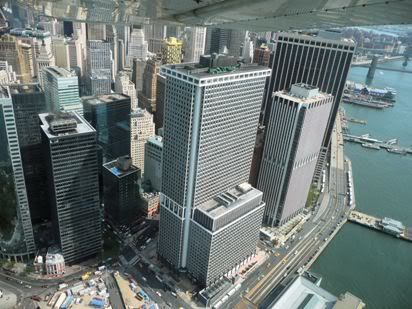
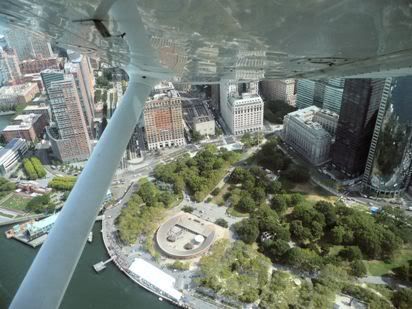
I called at the Holland Tunnel (clearly visible from the matching ventilation towers) and was past the worst of it. On the way passed, we spotted ‘Ground Zero’ between the buildings and of course Central Park. I spotted where my sister lives as she is virtually on the Hudson near Central Park.
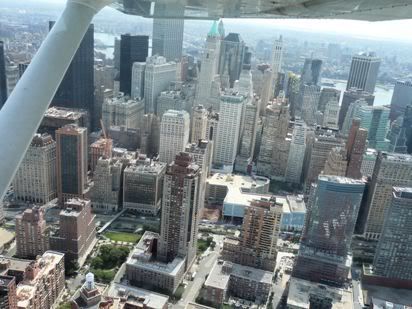
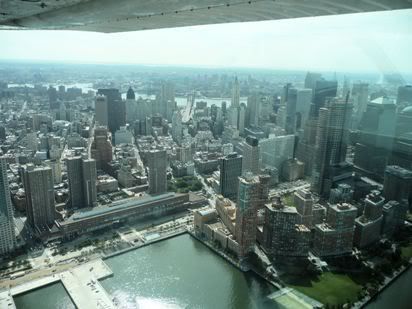
I bumbled on, starting to relax a bit now as we headed up-river back towards the Tappensee Bridge. I called Westchester Tower when I got to Tappensee and they gave me a squawk. I orbited while they picked up the squawk and they gave me a direct to right base for 16. I headed inland towards White Plains and searched for the airfield. We spotted the dam, so I knew I was on the right track. The Dan spotted the airfield and I started to line up.
I was lining up from about 5 miles and seemed to be on a direct to long final, so I continued. It was only a confusing minute later when I realised that I was busy lining up on the out-of-use runway 11. Embarrassed, I quickly entered right base to XX and lined up on about a two mile final. I was cleared to land and put her down nicely and took a right exit back to the now familiar Million Air hangar.
On shutdown, I asked the marshaller to fill her up ASAP while we adjourned to the terminal to pay fees and make personal preparations for the next leg of our trip from Westchester to Niagara International.
It was only a short trip, but what a flight. Yes the airspace is busy and it is hardly a relaxing flight, but it is quite simply THE most awesome, non-aerobatic flight I have ever done. If you haven’t done this, then you must! I can believe that it can be surpassed by some of the awesome scenery flying in the Grand Canyon or, say Monument Valley, but you won’t beat this for a city flight! It is a rare privilege in this security-obsessed day and age to be allowed to make a flight like this, especially in a city that has suffered so much and so recently.
It is a tribute to America and the enlightened approach of the FAA that we can fly such routes and to me clearly marks out the difference in attitude between the US and Europe. To me the European view is that ‘unless it says you can then you can’t’, the American view seeming to me to be the opposite.
Now - if only Americans could get Homeland Security to smile a bit and use common sense, this would be a ‘helluva’ country (as they say over here)!
Logged: 1.1 hours
Fuel: 41.5 litres
After staying in downtown New York for two nights and being shown the sights by my sister (who now lives in New York), we returned to Westchester via the commuter train to White Plains and a pick-up by Million Air, our flight handling service.
I spoke to the Million Air reception about the bill and explained that I was going on a ‘local’ around the NY low-level route and would return to Westchester for a fuel top up and would prefer to pay then. They were fine with this and confirmed that it had already been fully refuelled.
I got some helpful advice on the route from a local pilot, who confirmed what I already knew. Basically not above 1500’, but with some sections not above 1100’ (so I decided to stick with 1100’ for the whole route). South down the Hudson river following the west (right) side of the river. Self announce position reports on the specific frequency for the low level route of 123.05. Then around Ellis and Liberty Islands, back over Governors Island, quick peek at the East River, then hard left around Battery Park and back up the Hudson on the east side (right) flying past Manhattan, Greenwich Village, Central Park etc and back up to the Tappensee Bridge, then inland back to Westchester.
We wandered out and Dan prepped and packed the aircraft. We were good to go so we mounted up and I called Westchester Ground for taxi. I was instructed to taxi to the hold for runway 16.
I did the power checks and switched to Tower and called ready. They gave me a right turnout departure not above 1500'. So off we went.
I had not programmed anything in on the GPS and there were no radio beacons of any use, so I flew by map, time and compass bearing direct to the Tappensee Bridge, some 30 nautical miles up the Hudson River from Manhattan. This was not much of a navigational challenge as I only had to head west for 10 nm before I picked up the Hudson running North / South and you can hardly mistake the Hudson!


We hit the Tappensee Bridge pretty much spot on and proceeded down the Hudson river on the right hand side (western side), but still over the river itself. I changed frequency to 123.05 and started self-announcing. The frequency seemed full of others doing the same. All of the other aircraft seemed very well versed and slick in their calls and used all sorts of locations not marked on the map, so I immediately realised I was dealing with the professional helicopter jocks who I saw plying the low level route in their droves while on the ground in NY.
We plodded along at our stately 105kts as the skyline of NY hove into view with the also imposing New Jersey skyline on the near shore I was flying. It looked far more impressive in the early morning haze than photographs can possibly do justice to. I turned on every light and beacon I had and hoped that ’see and avoid’ worked both ways!
I called over the Holland Tunnel, took a deep breath, and plunged into the really busy part of the pattern. I kept a sharp lookout for traffic and maintained situational awareness while Dan snapped happily away with the camera.
We passed very close to a particularly tall New Jersey skyscraper outbound to Ellis and Liberty Islands.

On the way to them, I came across two helicopters, one above me (surely in controlled airspace?) and one below. I was sure we saw each other, so continued and passed vertically between them like a sandwich – it probably sounds more dramatic than it was as there was always a couple of hundred feet between us. Any other day, I might have been worried, but I suspected that this was ‘just another Wednesday’ on the NY low level route.


I turned left around Liberty Island with the iconic status of liberty and headed for Governors Island on the way to the East River. I only went far enough up the East River to check out the Brooklyn Bridge, then hauled the plane around into moderate left-hander to pass in front of Battery Park at the southern tip of Manhattan. Now we got some really ‘up close and personal’ photos of skyscrapers!


I was now on the right hand side (east) of the Hudson, over water of course and headed back up north. This was still a busy stretch but the worst was passed. I was still very busy flying the plane and keeping a lookout, but did managed some glances at the scenery – this isn’t the place for a relaxed and carefree bimble I can tell you!


I called at the Holland Tunnel (clearly visible from the matching ventilation towers) and was past the worst of it. On the way passed, we spotted ‘Ground Zero’ between the buildings and of course Central Park. I spotted where my sister lives as she is virtually on the Hudson near Central Park.


I bumbled on, starting to relax a bit now as we headed up-river back towards the Tappensee Bridge. I called Westchester Tower when I got to Tappensee and they gave me a squawk. I orbited while they picked up the squawk and they gave me a direct to right base for 16. I headed inland towards White Plains and searched for the airfield. We spotted the dam, so I knew I was on the right track. The Dan spotted the airfield and I started to line up.
I was lining up from about 5 miles and seemed to be on a direct to long final, so I continued. It was only a confusing minute later when I realised that I was busy lining up on the out-of-use runway 11. Embarrassed, I quickly entered right base to XX and lined up on about a two mile final. I was cleared to land and put her down nicely and took a right exit back to the now familiar Million Air hangar.
On shutdown, I asked the marshaller to fill her up ASAP while we adjourned to the terminal to pay fees and make personal preparations for the next leg of our trip from Westchester to Niagara International.
It was only a short trip, but what a flight. Yes the airspace is busy and it is hardly a relaxing flight, but it is quite simply THE most awesome, non-aerobatic flight I have ever done. If you haven’t done this, then you must! I can believe that it can be surpassed by some of the awesome scenery flying in the Grand Canyon or, say Monument Valley, but you won’t beat this for a city flight! It is a rare privilege in this security-obsessed day and age to be allowed to make a flight like this, especially in a city that has suffered so much and so recently.
It is a tribute to America and the enlightened approach of the FAA that we can fly such routes and to me clearly marks out the difference in attitude between the US and Europe. To me the European view is that ‘unless it says you can then you can’t’, the American view seeming to me to be the opposite.
Now - if only Americans could get Homeland Security to smile a bit and use common sense, this would be a ‘helluva’ country (as they say over here)!
CAN/USA: Massena to Westchester
Route: KMSS (Massena) DCT PLB DCT GFL DCT ALB DCT IGN DCT KIAG (Westchester)
Logged: 2.7 hours
Fuel: 95 litres
Massena was pretty deserted, certainly the main terminal was, so we mounted up and taxied across to the hangars on the other side of the airfield. Here we found a self-service fuel pump, so I pulled alongside to top up as the next leg was a three hour one.
I was trying to understand the instructions when a very helpful guy wandered over from one of the hangars and explained it to me. I topped up with about 35 litres (in US Gallons of course) and paid by credit card at the automated pump.
Dan discovered a PC and a telephone in the office of another hangar and I made my way over there to get a brief for the next leg. Sure enough, this was the briefing station and I got through immediately to 1-800-WX-BRIEF. Here I got a full set of NOTAM’s, a weather brief and filed a flight plan – what a fantastic and simple service. The guy said he would set the flight plan to activate automatically in 15 minutes to save me activating it once airborne.
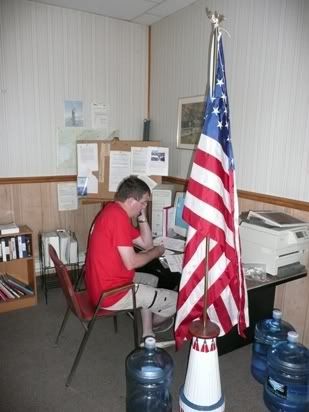
The weather was good except for the last 50 miles or so where they were forecasting a 60% chance of thunderstorms (not good!). I decided to give it a try and at least see how far we got as I had plenty of divert airfields all along the route.
As we were starting to mount up, someone wandered over from the hangar and said they had just had a phone call asking if we had arrived from the previous flight plan – lesson to learn – always close your own flight plan over the phone when you land! My mistake for the trip (I always seem to make one).
We climbed on board and checked the windsock. It still favoured 05, albeit with a healthy crosswind from the left (I guessed 350/12G17). Still nothing on the radio waves, so I self-announced and made a crosswind take-off heading broadly east towards Lake Champlain and the Adirondacks.
The route I planned took us initially ESE towards Lake Champlain, then virtually due south for the rest of the flight initially following Lake Champlain, then picking up and staying to the eastern side of the Hudson Valley all the way into Westchester.
I tried to contact Boston Centre on 135.25 but had no luck until I climbed to my cruise altitude of 3500’. When I asked for Flight Following they transferred me to another frequency, they in turn suggested someone else etc. I was getting the run-around. So I called up Flightwatch on 122.0 and asked them for a suitable frequency for flight following. They gave me Burlington on 122.2 and I got good FF from them.
We were heading towards the Adirondacks (the home of Lake Placid of winter Olympics fame) and crossed the ridge at a lower point with the heavily forested ground coming up to meet us a mere 600’ below, despite our 3500’. There were few if any places to set down in the event of an engine failure, except maybe one of the lakes. I could only imagine how beautiful this countryside must look every fall when the Maples change colour.
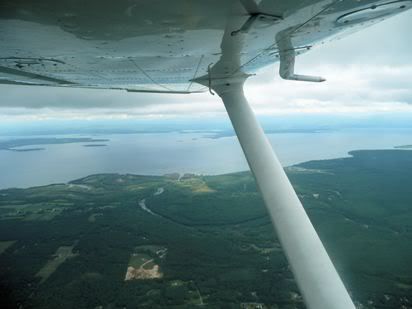
We crossed the ridge and saw the huge Lake Champlain running north / south in front of us. We turned en-route at Plattsburg VOR and instead of slavishly following my pre-planned ‘straight-line’ route to the GFL VOR, I followed the reasonably straight I87 freeway so that at least I would have somewhere to land if the engine quit. The mighty Garmin Pilot 3 GPS was providing sterling service as there were gaps in the VOR reception at this height. I could easily have gone up to 5500’ and even now wonder why I didn’t.
Then around Lake George, I got handed off to Albany approach on 122.95. They could hear me but couldn’t get my squawk and advised me to call them again closer to the GFL VOR when they should be able to see me. I was beginning to wonder of this flight following was as wonderful as I had been lead to believe (but I decided it really was the business later in the trip).
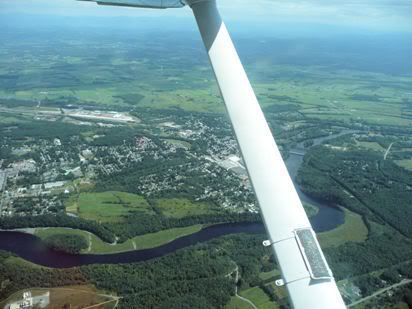
By now, Dan and I had noticed that the radio transmissions were very loud in our headsets, but the intercom was fairly quiet. So to hear each other on the intercom, we had to put up with a very loud radio. I searched in vain for a way of adjusting the intercom and decided that it must be such an early model that it was ‘built-in’ somewhere without controls to adjust it (an assumption that later returned to mock me). Still we chatted away while Dan took turns at playing ‘auto-pilot’ with myself.
I called Albany again about 10 miles north of Glen Falls and they were now getting my squawk. So we settled down to FF from them. They were an incredibly busy frequency with lots of commuter traffic and ‘heavies’ coming and going from Albany. The land below started to thin out now with significant clearings in the forest giving way to open land with small woods. You could almost see the money from this altitude on the small villages on the lake with large marinas.
We routed directly overhead Albany without a comment from ATC. What a HUGE and very busy airport it was as well – easily the size of Gatwick in the UK and try routing overhead that!
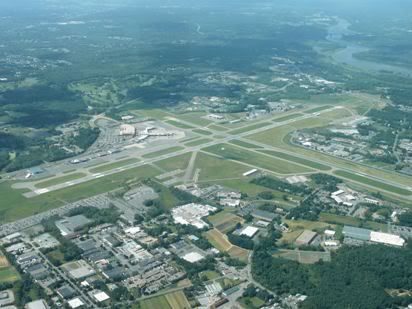
We continued with Albany FF en-route to IGN VOR. The weather was still with us, with scattered cumulus with bases at maybe 4500’ and nice and sunny in between. As we approached within 50 miles of our destination, we could see the visibility begin to drop and a more solid wall of cloud ahead – this must be the promised TCU’s!
At about 30 miles to run, we were handed off to New York Centre on 126.40. At the same time, we had to drop altitude to remain VMC. Initially to 2500’, then to 2000’. The visibility had dropped to probably 5 miles. The ground was still remarkably hilly and wooded, but with many large and imposing houses and country clubs – clearly an upmarket area. At 20 miles, New York handed us off to Westchester tower, by which time we were back up to 2500’. We got a warning of a converging Citation at the same level from our right. We heard his transmission that he had us on TCAS, then we saw him and called no conflict as he pulled ahead of us, clearly also headed for Westchester.
We spotted the airport and were given a right-hand downwind join for the runway in use 34. I dropped height to the required 1500’ QNH as we joined ‘American style’ (i.e. diagonal and converging to the downwind line) and called downwind.
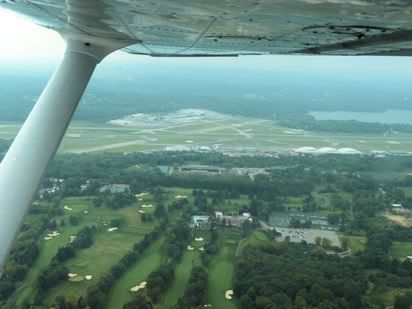
With such a busy frequency and airport, I was surprised to be given an immediate ‘clear to land’. We also heard transmissions to another Citation on long final asking him to slow up to let us in front of him. I gathered this and started a ‘military style’ descending turn from the end of the runway on the downwind leg with a curving approach to very short final. As I was on short final, I heard the controller give the Citation a ‘clear to land’. This got my attention – two people cleared to land on the same runway? So I called short final and I also got an unconcerned ‘clear to land’. Maybe this is how they do it in the US, but I found it pretty worrying knowing I had a Citation breathing down my neck, so I landed long-ish trying to aim to stop by a likely exit, which I just managed.

We were cleared to vacate left and change to Ground on 121.82. I asked ground for progressive taxi instructions to a flight handling outfit. I was offered two and opted for Million Air (having heard good things about them at OFC). I was patiently directed to the correct hangar. I queried the fact that it had ‘Westair’ on the hangar, but was told that this was Million Air. I saw a guy appearing to be marshalling someone, but as he wasn’t looking at me, I assumed a business jet would appear from around the corner so held position. Only after a minute did he gesture me and I realised he was trying to marshal me – ooops! So I followed his directions, parked up and switched off. We were greeted by helpful guy who held doors open and asked how long we were there. I told him the driver’s side door needed to be closed from the other side and he indicated where he would park it and that it would of course be chocked and tied down. I asked for it to be fuelled to the brim.
We unpacked and headed to the airside entrance of Million Air (hoping that the name was not an indication of the handling fees). We arrived and they told us that they would close the flight plan for us.
So there we are, in matching red ‘look at me’ trip t-shirts, in a very classy lounge with complimentary everything (yes, probably even that too), including showers and very nice toilets. There were some passengers and pilots (with four wanker bars on their shoulders) who had clearly just dis-embarked from a Citation already in the lounge. Well - they looked at us like we had crawled out from under a rock! I have to say I found this very entertaining, especially as Dan had located a beer with all the precision of a JDAM homing missile and proceeded to demolish it with relish and a loud show of appreciation – their faces – what a picture!
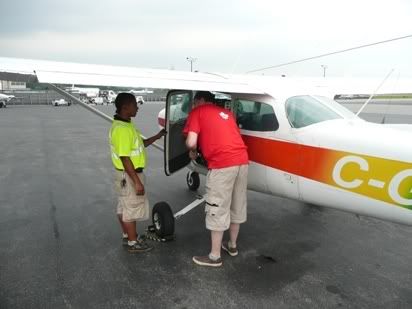
We asked about transport to New York and were immediately offered a ride into White Plains where we could catch one of the two trains every hour into Grand Central. The trip was easy as we wound around country roads between the states of New York and Connecticut looking in awe at the huge houses and country clubs. Apparently, this is a very classy ‘commuter town’ for New York. It too about 20 minutes to get to White Plains train station where we bought a one way ticket to New York for some $10. There are two trains, one on the hour which is virtually non-stop and takes 30 minutes and the other on the half-hour that stops several times and takes 45 minutes.
Well, we had made it, despite the weather forecast. The flying was very easy indeed and the radio work although initially challenging because it was so unfamiliar, was easy in the end (apart from the scare of clearing two people to land at the same time). The route and flight planning I had done in the UK certainly paid off. The flight handling and progressive taxi request at Westchester took a huge amount of stress out of the arrivals process at such a large and complex airport and I would recommend it for all but the simplest airports for the sake of a few bucks.
Logged: 2.7 hours
Fuel: 95 litres
Massena was pretty deserted, certainly the main terminal was, so we mounted up and taxied across to the hangars on the other side of the airfield. Here we found a self-service fuel pump, so I pulled alongside to top up as the next leg was a three hour one.
I was trying to understand the instructions when a very helpful guy wandered over from one of the hangars and explained it to me. I topped up with about 35 litres (in US Gallons of course) and paid by credit card at the automated pump.
Dan discovered a PC and a telephone in the office of another hangar and I made my way over there to get a brief for the next leg. Sure enough, this was the briefing station and I got through immediately to 1-800-WX-BRIEF. Here I got a full set of NOTAM’s, a weather brief and filed a flight plan – what a fantastic and simple service. The guy said he would set the flight plan to activate automatically in 15 minutes to save me activating it once airborne.

The weather was good except for the last 50 miles or so where they were forecasting a 60% chance of thunderstorms (not good!). I decided to give it a try and at least see how far we got as I had plenty of divert airfields all along the route.
As we were starting to mount up, someone wandered over from the hangar and said they had just had a phone call asking if we had arrived from the previous flight plan – lesson to learn – always close your own flight plan over the phone when you land! My mistake for the trip (I always seem to make one).
We climbed on board and checked the windsock. It still favoured 05, albeit with a healthy crosswind from the left (I guessed 350/12G17). Still nothing on the radio waves, so I self-announced and made a crosswind take-off heading broadly east towards Lake Champlain and the Adirondacks.
The route I planned took us initially ESE towards Lake Champlain, then virtually due south for the rest of the flight initially following Lake Champlain, then picking up and staying to the eastern side of the Hudson Valley all the way into Westchester.
I tried to contact Boston Centre on 135.25 but had no luck until I climbed to my cruise altitude of 3500’. When I asked for Flight Following they transferred me to another frequency, they in turn suggested someone else etc. I was getting the run-around. So I called up Flightwatch on 122.0 and asked them for a suitable frequency for flight following. They gave me Burlington on 122.2 and I got good FF from them.
We were heading towards the Adirondacks (the home of Lake Placid of winter Olympics fame) and crossed the ridge at a lower point with the heavily forested ground coming up to meet us a mere 600’ below, despite our 3500’. There were few if any places to set down in the event of an engine failure, except maybe one of the lakes. I could only imagine how beautiful this countryside must look every fall when the Maples change colour.

We crossed the ridge and saw the huge Lake Champlain running north / south in front of us. We turned en-route at Plattsburg VOR and instead of slavishly following my pre-planned ‘straight-line’ route to the GFL VOR, I followed the reasonably straight I87 freeway so that at least I would have somewhere to land if the engine quit. The mighty Garmin Pilot 3 GPS was providing sterling service as there were gaps in the VOR reception at this height. I could easily have gone up to 5500’ and even now wonder why I didn’t.
Then around Lake George, I got handed off to Albany approach on 122.95. They could hear me but couldn’t get my squawk and advised me to call them again closer to the GFL VOR when they should be able to see me. I was beginning to wonder of this flight following was as wonderful as I had been lead to believe (but I decided it really was the business later in the trip).

By now, Dan and I had noticed that the radio transmissions were very loud in our headsets, but the intercom was fairly quiet. So to hear each other on the intercom, we had to put up with a very loud radio. I searched in vain for a way of adjusting the intercom and decided that it must be such an early model that it was ‘built-in’ somewhere without controls to adjust it (an assumption that later returned to mock me). Still we chatted away while Dan took turns at playing ‘auto-pilot’ with myself.
I called Albany again about 10 miles north of Glen Falls and they were now getting my squawk. So we settled down to FF from them. They were an incredibly busy frequency with lots of commuter traffic and ‘heavies’ coming and going from Albany. The land below started to thin out now with significant clearings in the forest giving way to open land with small woods. You could almost see the money from this altitude on the small villages on the lake with large marinas.
We routed directly overhead Albany without a comment from ATC. What a HUGE and very busy airport it was as well – easily the size of Gatwick in the UK and try routing overhead that!

We continued with Albany FF en-route to IGN VOR. The weather was still with us, with scattered cumulus with bases at maybe 4500’ and nice and sunny in between. As we approached within 50 miles of our destination, we could see the visibility begin to drop and a more solid wall of cloud ahead – this must be the promised TCU’s!
At about 30 miles to run, we were handed off to New York Centre on 126.40. At the same time, we had to drop altitude to remain VMC. Initially to 2500’, then to 2000’. The visibility had dropped to probably 5 miles. The ground was still remarkably hilly and wooded, but with many large and imposing houses and country clubs – clearly an upmarket area. At 20 miles, New York handed us off to Westchester tower, by which time we were back up to 2500’. We got a warning of a converging Citation at the same level from our right. We heard his transmission that he had us on TCAS, then we saw him and called no conflict as he pulled ahead of us, clearly also headed for Westchester.
We spotted the airport and were given a right-hand downwind join for the runway in use 34. I dropped height to the required 1500’ QNH as we joined ‘American style’ (i.e. diagonal and converging to the downwind line) and called downwind.

With such a busy frequency and airport, I was surprised to be given an immediate ‘clear to land’. We also heard transmissions to another Citation on long final asking him to slow up to let us in front of him. I gathered this and started a ‘military style’ descending turn from the end of the runway on the downwind leg with a curving approach to very short final. As I was on short final, I heard the controller give the Citation a ‘clear to land’. This got my attention – two people cleared to land on the same runway? So I called short final and I also got an unconcerned ‘clear to land’. Maybe this is how they do it in the US, but I found it pretty worrying knowing I had a Citation breathing down my neck, so I landed long-ish trying to aim to stop by a likely exit, which I just managed.

We were cleared to vacate left and change to Ground on 121.82. I asked ground for progressive taxi instructions to a flight handling outfit. I was offered two and opted for Million Air (having heard good things about them at OFC). I was patiently directed to the correct hangar. I queried the fact that it had ‘Westair’ on the hangar, but was told that this was Million Air. I saw a guy appearing to be marshalling someone, but as he wasn’t looking at me, I assumed a business jet would appear from around the corner so held position. Only after a minute did he gesture me and I realised he was trying to marshal me – ooops! So I followed his directions, parked up and switched off. We were greeted by helpful guy who held doors open and asked how long we were there. I told him the driver’s side door needed to be closed from the other side and he indicated where he would park it and that it would of course be chocked and tied down. I asked for it to be fuelled to the brim.
We unpacked and headed to the airside entrance of Million Air (hoping that the name was not an indication of the handling fees). We arrived and they told us that they would close the flight plan for us.
So there we are, in matching red ‘look at me’ trip t-shirts, in a very classy lounge with complimentary everything (yes, probably even that too), including showers and very nice toilets. There were some passengers and pilots (with four wanker bars on their shoulders) who had clearly just dis-embarked from a Citation already in the lounge. Well - they looked at us like we had crawled out from under a rock! I have to say I found this very entertaining, especially as Dan had located a beer with all the precision of a JDAM homing missile and proceeded to demolish it with relish and a loud show of appreciation – their faces – what a picture!

We asked about transport to New York and were immediately offered a ride into White Plains where we could catch one of the two trains every hour into Grand Central. The trip was easy as we wound around country roads between the states of New York and Connecticut looking in awe at the huge houses and country clubs. Apparently, this is a very classy ‘commuter town’ for New York. It too about 20 minutes to get to White Plains train station where we bought a one way ticket to New York for some $10. There are two trains, one on the hour which is virtually non-stop and takes 30 minutes and the other on the half-hour that stops several times and takes 45 minutes.
Well, we had made it, despite the weather forecast. The flying was very easy indeed and the radio work although initially challenging because it was so unfamiliar, was easy in the end (apart from the scare of clearing two people to land at the same time). The route and flight planning I had done in the UK certainly paid off. The flight handling and progressive taxi request at Westchester took a huge amount of stress out of the arrivals process at such a large and complex airport and I would recommend it for all but the simplest airports for the sake of a few bucks.
CAN/USA:Ottawa to Massena
Route: CYOW (Ottawa International) DCT KMSS (Massena)
Logged: 0.8 hrs
Fuel: 33.5 litres
This was the first, and the all important leg on the whole tour, as this was the leg where I had to clear US customs and the all-seeing and all-knowing ‘Homeland Security’! I had read up on this extensively and very carefully. The requirements are:
Before take-off
- Call US customs 2 hours before arrival
- File a flight plan, get weather and NOTAMs
- Buy and display a US customs decal ($25)
- Complete and fax form CBP178 2 hours prior
In flight
- Establish comms with US centre and get squawk before crossing border
After landing
- Do NOT leave ther plane until state ETA has passed
- If customs don't show, call them and get clearance and badge number
The key thing here is that if you are a UK citizen, you MUST have a specific visa to cross the border in a light aircraft (i.e. you can’t do this on the visa waiver program). From my point of view they key point was that I am a Canadian citizen who lives (currently) permanently in the UK. So on the US Form 178, I recorded my citizenship, but of course put my UK address as my permanent address. I hoped this wouldn’t raise any eyebrows, but of course it did! So Brit pilots, please don’t try crossing from Canada to the USA in a light aircraft without a full visa!!
We turned up at the airport in plenty of time, as we needed two hours minimum notice for US Homeland Security. So first thing I did was to call Massena customs on the number I got. They didn’t want to know anything specific and merely gave me the number to fax the form to. This I did and got a printout of the transmission confirmation from the fax machine on the standard office practice basis that if you get this, you won’t need it, but if you don’t, they will deny receiving it! I know I am sounding paranoid about border crossing!
I then got Dan loading the aircraft up while I checked and liberated the documents required for international flight in both Canada and the USA from the flying club (they were very helpful and it was all nicely packaged up).
I entered details of my trip onto the impressive and all-embracing OFC computer system so they knew where I planned to be and when.
I trotted out to the plane and started a thorough A-check. It was already filled to the brim with fuel and the oil was full and looked new. I checked Dan’s loading (which was excellent). The plane was loaded, checked and complete, so Dan and I returned to the clubhouse for a coffee, while I tried the Canadian equivalent of WX-BRIEF for NOTAM’s, Weather and filing a flight plane.
I called 1-866-WXBRIEF. I was put automatically through to the Quebec region. I asked for the full set. There wasn’t much to say about either the weather or NOTAM’s as the day was good, with broken thin cumulus at 4000’. I filed the flight plan to start at 10:45 local (14:45 Zulu), giving us an easy 0:45 to get to Massena. Remember, it is vital that you arrive at your stated destination within 15 minutes of the stated time – hence my reason for choosing an airport in the USA that was just across the border, and therefore a very short flight – the further the airport and the longer the flight, the longer there is for winds, weather or whatever to interfere with your timings and to risk arrival outside of the half-hour window, thus incurring the wrath and full force of bureaucracy that only Homeland Security can deliver!
I have to say that this WX-BRIEF stuff is absolutely fantastic! Everything under one roof and you get to speak to a real person to boot – WOW!!!!
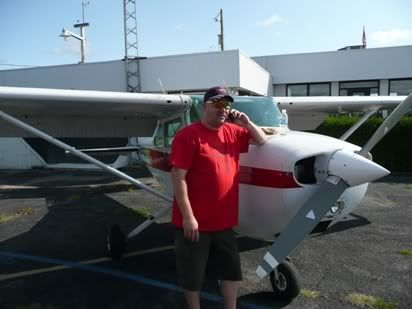
Just as I was about to mount up, we got a call on the mobile, first from Dan’s wife giving us a weather update (which she generally continued to do for every leg), then we got a phone call from Homeland Security. They spoke to me and said:
HS: ‘Can you please tell me your citizenship?’
Me: ‘Sure, Canadian as I put on the form’
HS: ‘But you put down a UK address’
Me: ‘Yes, I am a Canadian citizen, but I live in the UK’
HS: ‘I see (he didn’t)…..and you have proof that you are a Canadian citizen?’
Me: ‘Yes, a current Canadian passport’
HS: ‘I see (he didn’t)….British citizens must have a full visa to fly a light aircraft into the USA’
Me: ‘Uh….. yeah sure……, but I’m a Canadian citizen’
HS: ‘I see (he didn’t)….and you have DOCUMENTARY proof of this?’
Me: ‘Yes, a Canadian passport’
HS: ‘Do you have a Canadian pilots licence?’
Me: ‘Yes I do’
HS: ‘What is the number?’
Me: ‘I thought I put it on the form?’
HS: ‘No you didn’t’ (checking later it WAS clearly there)
Me: ‘My licence is XXXXXXXXXX’
HS: ‘I see…..well……that SHOULD be OK – have a nice day’
Well that takes the cake as the weirdest and most pointless phone call I have ever received in my life. The guys voice was humourless and robotic and reminded me of the immortal line in the Blues Brothers film where they announced ‘the use of deadly force has been authorised’. Oh boy, this Homeland Security stuff looks set to be fun – I can already hear the ‘whap’ of surgical latex gloves being donned prior to being given a body cavity search!
We mounted up at 10:30 as I worked my way carefully through the checklist. I picked up the ATIS. The winds had changed since yesterday (about 330 / 10) and they now vaguely favoured runway 22. I called Ottawa Ground on 121.90 who cleared me to taxi via taxiway papa to the holding point for runway 04. I completed the power checks and switched to Ottawa Tower on 118.80 and called ready for departure. I got immediate clearance with a right turnout onto track, not above 1500’.
So I switched everything on (i.e. GPS and Transponder), lined up and took off using a crosswind technique. Despite max fuel, two hefty guys and reasonable baggage, we are still 400lbs short of MAUW, to the plane took off quickly and easily. I climbed out and came onto track, which took us parallel to Ottawa International, so we managed to get some decent photos. Tower switched me to Ottawa TML on 127.70. I settled down into the cruise and leaned the mixture.
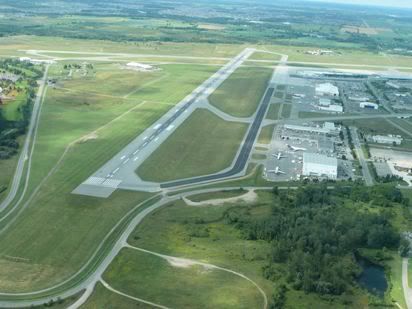
For this trip, I anticipated a basic VFR fit to any aircraft I hired, but was hoping for working VOR’s (which I got). I planned the entire trip generally around a combination of visual features and VOR’s. However, there was no DME. So what I did in advance was to programme all of the airfields and VOR’s into my old hand-held GPS (a Garmin Pilot III – no longer sold), which of course only had the European database on it. I also programmed in all of the routes and saved these. So I tinkered with the GPS to start the route while Dan held the plane steady.
Ottawa release me as I left their area, so I climbed to a modest 3000’ as I didn’t have far to go. I contacted Boston Centre on 135.25 who gave me the required squawk for border crossing. They didn’t pick up my squawk but said their coverage at that height in that area was normally not good. I wasn’t concerned about this other than for the legalities of border crossing. So I asked if I had their permission to cross the border. After a confusing conversation where they said they weren’t border security (I kinda figured that) I simply said that I was contacting them and getting a squawk as required by border crossing procedures. They confirmed as far as they were concerned, I was OK to cross and land at Massena.
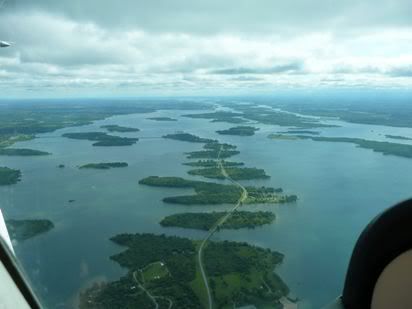
I was starting to stress myself out with this border crossing stuff – the flying is easy! We crossed the St Lawrence into American airspace and quickly spotted Massena airfield. I called on the required frequency of 123.00 but no reply. I was ready for this, so continued to give blind calls as I progressed around the circuit. I saw from the windsock that the winds favoured 05. So I swung around on a standard left had circuit to land. The first approach was too high (I cut it too soon onto base and final)so rather than try to sideslip it off on short final, I decided to go around – no hurry. Second approach was much better so I landed off this one.

Still no reply from the radio, and a quick look around the airfield indicated building in two areas on opposite sides of the airfield – now where would Homeland Security be? I decided to taxi to the more formal looking building, which turned out to be the main terminal (deserted of course).
The time? Precisely the 11:30 I had advise customs about. Damn I’m good! We taxied in and shut down. Checked the time again (as you are not allowed to even open the door of the aircraft before the stated time unless instructed to do so by Homeland Security). Yep – 11:30 alright! We looked around for a car or people and spotted a 4X4 festooned with lights and an official looking colour scheme with two people sat in it glowering at us (well – I guessed they were glowering – it was hard to tell from 50m!).
As we shut down and sat there, they also sat in their car – I could almost hear the spaghetti western music start up and pictured the scene from ‘The good, the bad and the ugly’ where the three gunslingers eyed each other in the heat looking for who would make the first move! (Yes – I have waaaayyyy too much imagination). They walked towards the plane so we started to get out – and mighty ungainly I was as I caught my foot in the seat runner and nearly fell at the feet of the unsmiling lady officials!
My humorous ‘well, that’s a graceful way to make an entrance’ comment was greeted by stony silence and a rather silly ‘Is this you aircraft sir?’. To which of course all I could say was ‘No’ - well it went downhill after that! I decided at that point that you only answer their questions, don’t volunteer anything and don’t try to be funny.
HS1: ‘I see (they didn’t!), where did you rent it from’
Me: ‘Ottawa Flying Club …….in Ottawa (trying to restrain any trace of irony in my voice)’
HS1: ‘I see (they didn’t), and did you have their permission?’
Me: ‘Yes (no I stole it what do you think)’
HS1: ‘I see (they didn’t), do you have a renter’s agreement?
HS2: ‘They don’t have those in Canada (my God - this one talks too!)’
HS1: ‘I see (she didn’t), passports please’
I produced both mine and Dan’s passports. I also had my old cancelled one as it has a stamp of permanent residence for the UK that UK borders like to see.
HS1: ‘I want to see THAT one!’ (pointing at the cancelled passport I was putting away).
She glanced at the current passports and went through my cancelled passport with an electron microscope (OK I exaggerate, but not much!).
HS1: ‘Why are you in the USA?’
Me: ‘A three day flying tour, initially down to New York to see my sister’
HS1: ‘What is your pilot licence number’
Me: ‘I did put it on the form, but it is XXXXXXX’
HS1: ‘It wasn’t on the form (oh yes it was!!!)’
Me: ‘I see (I didn’t)’
HS1: ‘How do you know each other?’
Dan: ‘I was posted to the UK for three years where I met Steve’ (I was glad Dan jumped in as I was about to answer ‘very well actually’).
HS1: ‘I see (she didn’t), do you have military ID (looking at Dan)’
Dan: ‘Yes, this is my warrant card’
HS1: ‘I see (she didn’t), and are you still in the military (looking doubtfully at Dan’s impressive 6’2” and 250lb frame)?’
Dan: ‘Yes (If I weren’t in the military would I have a current card)’
HS1: ‘I see (she didn’t), what rank are you?’
Dan: ‘Warrant Officer (not called this in the US military so you wouldn’t know)’
HS1: 'I see errrrr.....'
She didn’t – looks hesitantly at HS2 – they look at each other then back at us – stood there like idiots in matching bright red t-shirts that say ‘Puck off – I’m Canadian’.
HS2: ‘Enjoy your visit – have a nice day (not meaning a single word of it)’
As they stalked off back to their own personal ozone-hole-creating V8 4X4 and roared off back to presumably the Men In Black HQ.
WELL! If I thought my first encounter with Homeland Security was weird, this one took the biscuit. If it weren’t so serious in intent, it would have been the most hilarious thing I have ever been through. But my advice is keep a straight face and answer their questions, no matter how stupid and even when they get their fact wrong, they are still right. It does strike me that it is the usual government thing though – the all important appearance of being seen to be doing something no matter how much it ignores the real threat or how ineffective it is – tighten up on the easy and obvious!
Wow! Major sigh of relief as we explore the deserted terminal. Someone drives across from the other side of the airfield on their way out and we ask about fuel and flight planning. He is very helpful and friendly and points us at the hangars on the other side of the airfield, so we mount up, start up and taxi across.
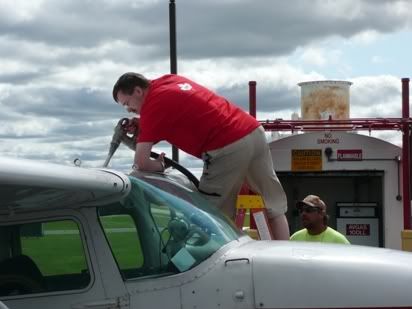
Well that’s the first leg over and I have to say I found it incredibly stressful, not because of the flying (that was easy), but because of the border crossing routine. Well, it will be easier from this point on I hope and I guess border security people aren’t the friendliest people in the world in any country (actually that’s a lie as I find the UK guys very good and friendly, even cracking jokes about the weather).
Well, we are in the USA now and all set to get prepped again and head to New York.
Logged: 0.8 hrs
Fuel: 33.5 litres
This was the first, and the all important leg on the whole tour, as this was the leg where I had to clear US customs and the all-seeing and all-knowing ‘Homeland Security’! I had read up on this extensively and very carefully. The requirements are:
Before take-off
- Call US customs 2 hours before arrival
- File a flight plan, get weather and NOTAMs
- Buy and display a US customs decal ($25)
- Complete and fax form CBP178 2 hours prior
In flight
- Establish comms with US centre and get squawk before crossing border
After landing
- Do NOT leave ther plane until state ETA has passed
- If customs don't show, call them and get clearance and badge number
The key thing here is that if you are a UK citizen, you MUST have a specific visa to cross the border in a light aircraft (i.e. you can’t do this on the visa waiver program). From my point of view they key point was that I am a Canadian citizen who lives (currently) permanently in the UK. So on the US Form 178, I recorded my citizenship, but of course put my UK address as my permanent address. I hoped this wouldn’t raise any eyebrows, but of course it did! So Brit pilots, please don’t try crossing from Canada to the USA in a light aircraft without a full visa!!
We turned up at the airport in plenty of time, as we needed two hours minimum notice for US Homeland Security. So first thing I did was to call Massena customs on the number I got. They didn’t want to know anything specific and merely gave me the number to fax the form to. This I did and got a printout of the transmission confirmation from the fax machine on the standard office practice basis that if you get this, you won’t need it, but if you don’t, they will deny receiving it! I know I am sounding paranoid about border crossing!
I then got Dan loading the aircraft up while I checked and liberated the documents required for international flight in both Canada and the USA from the flying club (they were very helpful and it was all nicely packaged up).
I entered details of my trip onto the impressive and all-embracing OFC computer system so they knew where I planned to be and when.
I trotted out to the plane and started a thorough A-check. It was already filled to the brim with fuel and the oil was full and looked new. I checked Dan’s loading (which was excellent). The plane was loaded, checked and complete, so Dan and I returned to the clubhouse for a coffee, while I tried the Canadian equivalent of WX-BRIEF for NOTAM’s, Weather and filing a flight plane.
I called 1-866-WXBRIEF. I was put automatically through to the Quebec region. I asked for the full set. There wasn’t much to say about either the weather or NOTAM’s as the day was good, with broken thin cumulus at 4000’. I filed the flight plan to start at 10:45 local (14:45 Zulu), giving us an easy 0:45 to get to Massena. Remember, it is vital that you arrive at your stated destination within 15 minutes of the stated time – hence my reason for choosing an airport in the USA that was just across the border, and therefore a very short flight – the further the airport and the longer the flight, the longer there is for winds, weather or whatever to interfere with your timings and to risk arrival outside of the half-hour window, thus incurring the wrath and full force of bureaucracy that only Homeland Security can deliver!
I have to say that this WX-BRIEF stuff is absolutely fantastic! Everything under one roof and you get to speak to a real person to boot – WOW!!!!

Just as I was about to mount up, we got a call on the mobile, first from Dan’s wife giving us a weather update (which she generally continued to do for every leg), then we got a phone call from Homeland Security. They spoke to me and said:
HS: ‘Can you please tell me your citizenship?’
Me: ‘Sure, Canadian as I put on the form’
HS: ‘But you put down a UK address’
Me: ‘Yes, I am a Canadian citizen, but I live in the UK’
HS: ‘I see (he didn’t)…..and you have proof that you are a Canadian citizen?’
Me: ‘Yes, a current Canadian passport’
HS: ‘I see (he didn’t)….British citizens must have a full visa to fly a light aircraft into the USA’
Me: ‘Uh….. yeah sure……, but I’m a Canadian citizen’
HS: ‘I see (he didn’t)….and you have DOCUMENTARY proof of this?’
Me: ‘Yes, a Canadian passport’
HS: ‘Do you have a Canadian pilots licence?’
Me: ‘Yes I do’
HS: ‘What is the number?’
Me: ‘I thought I put it on the form?’
HS: ‘No you didn’t’ (checking later it WAS clearly there)
Me: ‘My licence is XXXXXXXXXX’
HS: ‘I see…..well……that SHOULD be OK – have a nice day’
Well that takes the cake as the weirdest and most pointless phone call I have ever received in my life. The guys voice was humourless and robotic and reminded me of the immortal line in the Blues Brothers film where they announced ‘the use of deadly force has been authorised’. Oh boy, this Homeland Security stuff looks set to be fun – I can already hear the ‘whap’ of surgical latex gloves being donned prior to being given a body cavity search!
We mounted up at 10:30 as I worked my way carefully through the checklist. I picked up the ATIS. The winds had changed since yesterday (about 330 / 10) and they now vaguely favoured runway 22. I called Ottawa Ground on 121.90 who cleared me to taxi via taxiway papa to the holding point for runway 04. I completed the power checks and switched to Ottawa Tower on 118.80 and called ready for departure. I got immediate clearance with a right turnout onto track, not above 1500’.
So I switched everything on (i.e. GPS and Transponder), lined up and took off using a crosswind technique. Despite max fuel, two hefty guys and reasonable baggage, we are still 400lbs short of MAUW, to the plane took off quickly and easily. I climbed out and came onto track, which took us parallel to Ottawa International, so we managed to get some decent photos. Tower switched me to Ottawa TML on 127.70. I settled down into the cruise and leaned the mixture.

For this trip, I anticipated a basic VFR fit to any aircraft I hired, but was hoping for working VOR’s (which I got). I planned the entire trip generally around a combination of visual features and VOR’s. However, there was no DME. So what I did in advance was to programme all of the airfields and VOR’s into my old hand-held GPS (a Garmin Pilot III – no longer sold), which of course only had the European database on it. I also programmed in all of the routes and saved these. So I tinkered with the GPS to start the route while Dan held the plane steady.
Ottawa release me as I left their area, so I climbed to a modest 3000’ as I didn’t have far to go. I contacted Boston Centre on 135.25 who gave me the required squawk for border crossing. They didn’t pick up my squawk but said their coverage at that height in that area was normally not good. I wasn’t concerned about this other than for the legalities of border crossing. So I asked if I had their permission to cross the border. After a confusing conversation where they said they weren’t border security (I kinda figured that) I simply said that I was contacting them and getting a squawk as required by border crossing procedures. They confirmed as far as they were concerned, I was OK to cross and land at Massena.

I was starting to stress myself out with this border crossing stuff – the flying is easy! We crossed the St Lawrence into American airspace and quickly spotted Massena airfield. I called on the required frequency of 123.00 but no reply. I was ready for this, so continued to give blind calls as I progressed around the circuit. I saw from the windsock that the winds favoured 05. So I swung around on a standard left had circuit to land. The first approach was too high (I cut it too soon onto base and final)so rather than try to sideslip it off on short final, I decided to go around – no hurry. Second approach was much better so I landed off this one.

Still no reply from the radio, and a quick look around the airfield indicated building in two areas on opposite sides of the airfield – now where would Homeland Security be? I decided to taxi to the more formal looking building, which turned out to be the main terminal (deserted of course).
The time? Precisely the 11:30 I had advise customs about. Damn I’m good! We taxied in and shut down. Checked the time again (as you are not allowed to even open the door of the aircraft before the stated time unless instructed to do so by Homeland Security). Yep – 11:30 alright! We looked around for a car or people and spotted a 4X4 festooned with lights and an official looking colour scheme with two people sat in it glowering at us (well – I guessed they were glowering – it was hard to tell from 50m!).
As we shut down and sat there, they also sat in their car – I could almost hear the spaghetti western music start up and pictured the scene from ‘The good, the bad and the ugly’ where the three gunslingers eyed each other in the heat looking for who would make the first move! (Yes – I have waaaayyyy too much imagination). They walked towards the plane so we started to get out – and mighty ungainly I was as I caught my foot in the seat runner and nearly fell at the feet of the unsmiling lady officials!
My humorous ‘well, that’s a graceful way to make an entrance’ comment was greeted by stony silence and a rather silly ‘Is this you aircraft sir?’. To which of course all I could say was ‘No’ - well it went downhill after that! I decided at that point that you only answer their questions, don’t volunteer anything and don’t try to be funny.
HS1: ‘I see (they didn’t!), where did you rent it from’
Me: ‘Ottawa Flying Club …….in Ottawa (trying to restrain any trace of irony in my voice)’
HS1: ‘I see (they didn’t), and did you have their permission?’
Me: ‘Yes (no I stole it what do you think)’
HS1: ‘I see (they didn’t), do you have a renter’s agreement?
HS2: ‘They don’t have those in Canada (my God - this one talks too!)’
HS1: ‘I see (she didn’t), passports please’
I produced both mine and Dan’s passports. I also had my old cancelled one as it has a stamp of permanent residence for the UK that UK borders like to see.
HS1: ‘I want to see THAT one!’ (pointing at the cancelled passport I was putting away).
She glanced at the current passports and went through my cancelled passport with an electron microscope (OK I exaggerate, but not much!).
HS1: ‘Why are you in the USA?’
Me: ‘A three day flying tour, initially down to New York to see my sister’
HS1: ‘What is your pilot licence number’
Me: ‘I did put it on the form, but it is XXXXXXX’
HS1: ‘It wasn’t on the form (oh yes it was!!!)’
Me: ‘I see (I didn’t)’
HS1: ‘How do you know each other?’
Dan: ‘I was posted to the UK for three years where I met Steve’ (I was glad Dan jumped in as I was about to answer ‘very well actually’).
HS1: ‘I see (she didn’t), do you have military ID (looking at Dan)’
Dan: ‘Yes, this is my warrant card’
HS1: ‘I see (she didn’t), and are you still in the military (looking doubtfully at Dan’s impressive 6’2” and 250lb frame)?’
Dan: ‘Yes (If I weren’t in the military would I have a current card)’
HS1: ‘I see (she didn’t), what rank are you?’
Dan: ‘Warrant Officer (not called this in the US military so you wouldn’t know)’
HS1: 'I see errrrr.....'
She didn’t – looks hesitantly at HS2 – they look at each other then back at us – stood there like idiots in matching bright red t-shirts that say ‘Puck off – I’m Canadian’.
HS2: ‘Enjoy your visit – have a nice day (not meaning a single word of it)’
As they stalked off back to their own personal ozone-hole-creating V8 4X4 and roared off back to presumably the Men In Black HQ.
WELL! If I thought my first encounter with Homeland Security was weird, this one took the biscuit. If it weren’t so serious in intent, it would have been the most hilarious thing I have ever been through. But my advice is keep a straight face and answer their questions, no matter how stupid and even when they get their fact wrong, they are still right. It does strike me that it is the usual government thing though – the all important appearance of being seen to be doing something no matter how much it ignores the real threat or how ineffective it is – tighten up on the easy and obvious!
Wow! Major sigh of relief as we explore the deserted terminal. Someone drives across from the other side of the airfield on their way out and we ask about fuel and flight planning. He is very helpful and friendly and points us at the hangars on the other side of the airfield, so we mount up, start up and taxi across.

Well that’s the first leg over and I have to say I found it incredibly stressful, not because of the flying (that was easy), but because of the border crossing routine. Well, it will be easier from this point on I hope and I guess border security people aren’t the friendliest people in the world in any country (actually that’s a lie as I find the UK guys very good and friendly, even cracking jokes about the weather).
Well, we are in the USA now and all set to get prepped again and head to New York.
CAN/USA: C172 Sign Off
I arrived in Ottawa as advertised on Saturday 23rd August, as advertised, courtesy of Zoom Airlines (yes, I know – but that’s another story!). I had a restrained evening with my buddy knowing that I was going for a checkride at Ottawa Flying Club at midday the next day.
I arrived at Ottawa Flying Club about half an hour beforehand. OFC is based at Ottawa International Airport, but at one end of the airport (accessed by a different access road) and with what is in effect, its own runway.
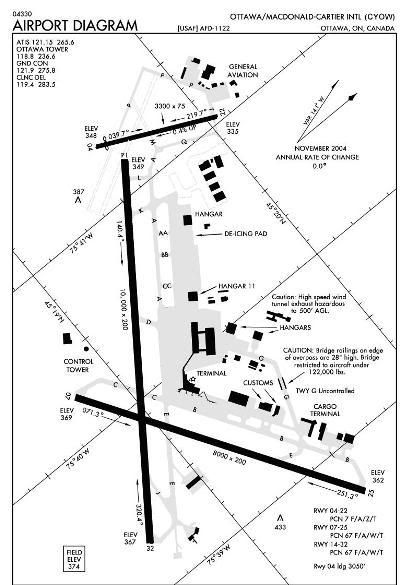
I checked in with reception and was introduced to my instructor, an affable guy called Ken Wright. Ken started with the dreaded words……’ hasn’t anyone been in touch with you?’. Anticipating disaster or more bureaucratic hurdles, he went on to say that the C172 I had booked (C-GCOH) was in the workshops and that there wasn’t another C172 available just now. I patiently asked him why CGCOH was in the workshops and what they could do about a checkride today. He explained that C-GCOH was in purely to have a new starter arm fitted and would be ready by 17:00 latest that day. We could either postpone the checkride until then or he could try to scare up another C172. I went for the latter option as the sky was starting to look menacing with possible TCU forecast as the afternoon wore on.
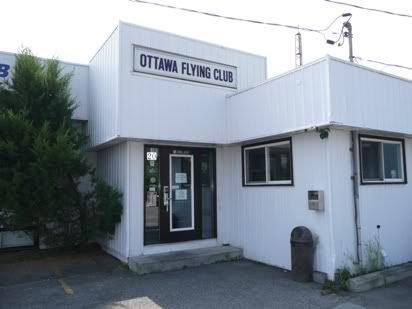
He came back and found that we could do a checkride in a C172 at about 14:00. I agreed to this and hung around chatting until I saw the plane taxi back in at the promised time.
Ken had a look at my logbook and seemed happy with my experience and currency and asked ‘So what do you want to do?’. I replied that it was more a question for him as he was the guy the club expected to be happy about me as I was planning on taking one of their C172’s away for four days flying in Canada and the USA. He thought about this and decided ‘OK, let’s go do a few circuits’ – my kind of guy!
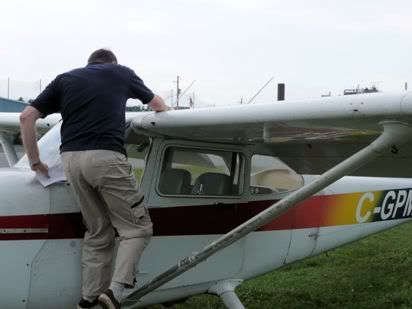
We talked about local radio, arrival and departure differences. Being based at a busy national and international airport makes a bit of a difference, although not actually much different from Gloucester (where I am based) as it turned out. We booked out and were allocated a squawk. I checked out the C172. Well, it was certainly well worn, with lots of bare patches in the paint and pretty scruffy on the inside, but mechanically sound I was told. I was assured that C-GCOH was much tidier.
We started up called Ottawa Ground for clearance and taxied the short distance to the hold for runway 22 and did the power checks. All went well as we switched to Ottawa Tower and were given permission to ‘line up and wait’. I read this back and Ken was surprised as apparently ‘line up and wait’ is ‘new’ terminology in Canada as was the requirement to read it back. I explained this was standard in the UK and would probably have been confused by any other terminology. So again, it seemed likely to me that the radio work would be the hardest part of the trip!
We powered up and took off smoothly with circuits to the right. All circuits on this GA runway are to the north west. You have to be a bit careful in USA and Canada as some of the plates (indeed the local area map for Toronto / Ottawa) are NOT aligned with N/S up – so holding the map upright may be with grid north and the grid lines pointing diagonally – I found this disconcerting!
Ken pointed out the local turning points for circuits. While doing circuits I asked him about the C172 ‘rule’ that didn’t allow side-slipping with flaps. He was dismissive and said the blanking effect on the elevators only lead to a bit of nodding and that side-slipping was fine – suits me!
The first circuit was OK. Oddly though on the flare, I over-controlled it a bit and twice ballooned slightly, although landed OK in the end. I apologised for the somewhat hesitant landing but Ken was fine about it as I vowed to nail it the next time.
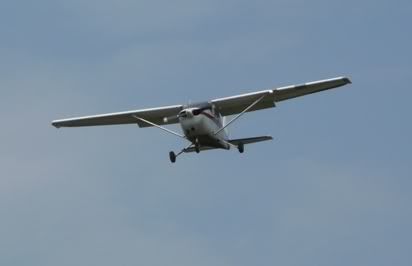
Basically, the next three circuits were fine as we landed off the fourth circuit.
I taxied back and followed the OFC checklist. I noted with interest the OFC insistence on doing a magneto ‘dead-cut check’ immediately before shutdown. This I did and very nearly turned the mags back through both onto start again. He pointed out that that was how the starter arm got sheared in the first place! Yeah – I can see that! I did ask why they did this ‘dead cut’ check as this was the first I had seen of it in training. I never cease to be amazed at how procedures vary and how one particular school may have a ‘bee in its bonnet’ about one aspect that another doesn’t much care about etc. Suffice to say that it is highly likely that I will ‘forget’ to do the dead cut check when I am renting the plane rather than risk a wrecked starter arm or motor!
At the debrief, I asked Ken about Ottawa departure and arrival procedures, but he said they would route me as they required and were not frantic about using published VRP’s, indeed they would often use ‘local-knowledge’ VRP’s (which is what I was afraid of).
Ken signed me off for hire and asked about our planned route. Apparently a ‘posse’ of them had earlier been out to the west coast of the USA and back. He thought we would have a great time on our planned route. He also emphasised that our hire plane, C-GCOH had the standard tanks, although it was an excellent weight-lifter (he said eyeing me at 210 lbs and Dan at 250 lbs). I replied that I knew this from the published W&B sheet and was strictly limiting myself to no leg longer than three hours, which would leave a pone hour reserve. He confirmed that this was the rule they used as well.
Well, he was happy and so was I. He did confide that the head mechanic working on C-GCOH had asked him about us and seemed worried about ‘some new guys from the UK taking the plane away’ – apparently he replied that he was the instructor and that if he said we were OK, then we were. Nice of him I thought.
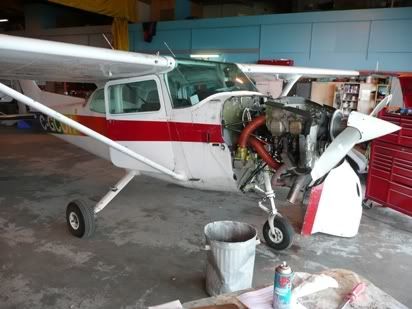
We had a quick look at the now assembled and ready for service C-GCOH. It did at least have all of the paint on all of the surfaces I would have expected. The inside was tidier, but did have several yellow notices referring to U/S equipment. It was a basic VFR fit with two functioning VOR (but a U/S glide-slope). The pilot-side door would not hold on the latch and had to be closed and latched from the inside using the passenger door. Other than that, I couldn’t see any other ‘foibles’.
So we left OFC for a quick tour of the Ottawa War Museum and a restrained BBQ and a few beers back at Dan’s place.
I arrived at Ottawa Flying Club about half an hour beforehand. OFC is based at Ottawa International Airport, but at one end of the airport (accessed by a different access road) and with what is in effect, its own runway.

I checked in with reception and was introduced to my instructor, an affable guy called Ken Wright. Ken started with the dreaded words……’ hasn’t anyone been in touch with you?’. Anticipating disaster or more bureaucratic hurdles, he went on to say that the C172 I had booked (C-GCOH) was in the workshops and that there wasn’t another C172 available just now. I patiently asked him why CGCOH was in the workshops and what they could do about a checkride today. He explained that C-GCOH was in purely to have a new starter arm fitted and would be ready by 17:00 latest that day. We could either postpone the checkride until then or he could try to scare up another C172. I went for the latter option as the sky was starting to look menacing with possible TCU forecast as the afternoon wore on.

He came back and found that we could do a checkride in a C172 at about 14:00. I agreed to this and hung around chatting until I saw the plane taxi back in at the promised time.
Ken had a look at my logbook and seemed happy with my experience and currency and asked ‘So what do you want to do?’. I replied that it was more a question for him as he was the guy the club expected to be happy about me as I was planning on taking one of their C172’s away for four days flying in Canada and the USA. He thought about this and decided ‘OK, let’s go do a few circuits’ – my kind of guy!

We talked about local radio, arrival and departure differences. Being based at a busy national and international airport makes a bit of a difference, although not actually much different from Gloucester (where I am based) as it turned out. We booked out and were allocated a squawk. I checked out the C172. Well, it was certainly well worn, with lots of bare patches in the paint and pretty scruffy on the inside, but mechanically sound I was told. I was assured that C-GCOH was much tidier.
We started up called Ottawa Ground for clearance and taxied the short distance to the hold for runway 22 and did the power checks. All went well as we switched to Ottawa Tower and were given permission to ‘line up and wait’. I read this back and Ken was surprised as apparently ‘line up and wait’ is ‘new’ terminology in Canada as was the requirement to read it back. I explained this was standard in the UK and would probably have been confused by any other terminology. So again, it seemed likely to me that the radio work would be the hardest part of the trip!
We powered up and took off smoothly with circuits to the right. All circuits on this GA runway are to the north west. You have to be a bit careful in USA and Canada as some of the plates (indeed the local area map for Toronto / Ottawa) are NOT aligned with N/S up – so holding the map upright may be with grid north and the grid lines pointing diagonally – I found this disconcerting!
Ken pointed out the local turning points for circuits. While doing circuits I asked him about the C172 ‘rule’ that didn’t allow side-slipping with flaps. He was dismissive and said the blanking effect on the elevators only lead to a bit of nodding and that side-slipping was fine – suits me!
The first circuit was OK. Oddly though on the flare, I over-controlled it a bit and twice ballooned slightly, although landed OK in the end. I apologised for the somewhat hesitant landing but Ken was fine about it as I vowed to nail it the next time.

Basically, the next three circuits were fine as we landed off the fourth circuit.
I taxied back and followed the OFC checklist. I noted with interest the OFC insistence on doing a magneto ‘dead-cut check’ immediately before shutdown. This I did and very nearly turned the mags back through both onto start again. He pointed out that that was how the starter arm got sheared in the first place! Yeah – I can see that! I did ask why they did this ‘dead cut’ check as this was the first I had seen of it in training. I never cease to be amazed at how procedures vary and how one particular school may have a ‘bee in its bonnet’ about one aspect that another doesn’t much care about etc. Suffice to say that it is highly likely that I will ‘forget’ to do the dead cut check when I am renting the plane rather than risk a wrecked starter arm or motor!
At the debrief, I asked Ken about Ottawa departure and arrival procedures, but he said they would route me as they required and were not frantic about using published VRP’s, indeed they would often use ‘local-knowledge’ VRP’s (which is what I was afraid of).
Ken signed me off for hire and asked about our planned route. Apparently a ‘posse’ of them had earlier been out to the west coast of the USA and back. He thought we would have a great time on our planned route. He also emphasised that our hire plane, C-GCOH had the standard tanks, although it was an excellent weight-lifter (he said eyeing me at 210 lbs and Dan at 250 lbs). I replied that I knew this from the published W&B sheet and was strictly limiting myself to no leg longer than three hours, which would leave a pone hour reserve. He confirmed that this was the rule they used as well.
Well, he was happy and so was I. He did confide that the head mechanic working on C-GCOH had asked him about us and seemed worried about ‘some new guys from the UK taking the plane away’ – apparently he replied that he was the instructor and that if he said we were OK, then we were. Nice of him I thought.

We had a quick look at the now assembled and ready for service C-GCOH. It did at least have all of the paint on all of the surfaces I would have expected. The inside was tidier, but did have several yellow notices referring to U/S equipment. It was a basic VFR fit with two functioning VOR (but a U/S glide-slope). The pilot-side door would not hold on the latch and had to be closed and latched from the inside using the passenger door. Other than that, I couldn’t see any other ‘foibles’.
So we left OFC for a quick tour of the Ottawa War Museum and a restrained BBQ and a few beers back at Dan’s place.
Subscribe to:
Comments (Atom)
